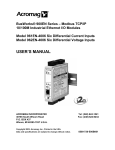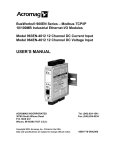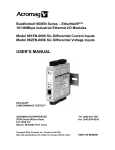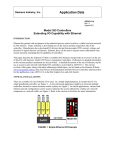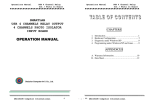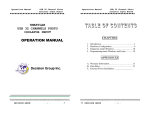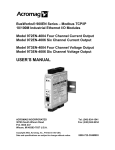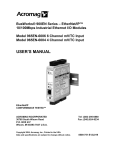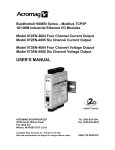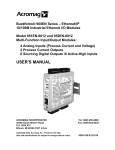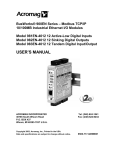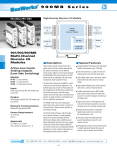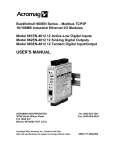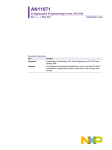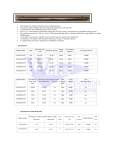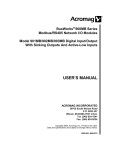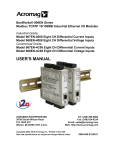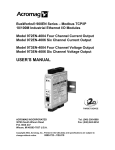Download BusWorks® 900EN Series – Modbus TCP/IP 10
Transcript
BusWorks® 900EN Series – Modbus TCP/IP 10/100M Industrial Ethernet I/O Modules Model 961EN-4006 Six Differential Current Inputs Model 962EN-4006 Six Differential Voltage Inputs USER’S MANUAL ACROMAG INCORPORATED 30765 South Wixom Road P.O. BOX 437 Wixom, MI 48393-7037 U.S.A. Copyright 2003, Acromag, Inc., Printed in the USA. Data and specifications are subject to change without notice. Tel: (248) 624-1541 Fax: (248) 624-9234 8500-720-C04J008 2 BusWorks® 961/962EN Module User’s Manual Ethernet Differential I/V Input __________________________________________________________________ TABLE OF CONTENTS Symbols on equipment: ! Means “Refer to User’s Manual (this manual) for additional information”. The information of this manual may change without notice. Acromag makes no warranty of any kind with regard to this material, including, but not limited to, the implied warranties of merchantability and fitness for a particular purpose. Further, Acromag assumes no responsibility for any errors that may appear in this manual and makes no commitment to update, or keep current, the information contained in this manual. No part of this manual may be copied or reproduced in any form without the prior written consent of Acromag, Inc. IMPORTANT SAFETY CONSIDERATIONS You must consider the possible negative effects of power, wiring, component, sensor, or software failure in the design of any type of control or monitoring system. This is very important where property loss or human life is involved. It is important that you perform satisfactory overall system design and it is agreed between you and Acromag, that this is your responsibility. GETTING STARTED MOUNTING AND DIMENSIONS……………………… CONTROLS & INDICATORS..………………………… ISOLATION BARRIERS..………………………………. CONNECTIONS…………………………………………. DIN-Rail Mounting And Removal……………… Network…………………………………………….. Power……………………………………………….. Analog Inputs……………………………………... Earth Ground..………………………………….…. WEB BROWSER………………………………………... Home Page………………………………………… Password Configuration Page.………………... Network Configuration Page…………………… Test Page………………………………………….. Calibration Page………………………………….. Input Calibration………………………………….. TROUBLESHOOTING………………………………….. Diagnostics Table……………………………..…. Trouble Browsing Your Module?..................... Getting Out Of Trouble………………………….. 3 3 3 4 4 4 6 6 7 8 8 9 9 12 13 15 16 16 17 17 TECHNICAL REFERENCE KEY FEATURES………………………………………… HOW IT WORKS………….…………………………….. ABOUT MODBUS TCP/IP….………………………….. IP Addressing…………..…………………………. Dynamic Host Configuration Protocol……….. Domain Name System (DNS)…………………… MODBUS REGISTERS………………………………… Register Functions………………………………. Register Mirroring……….……………………….. Data Types………………………………………… Register Map……………………………………… SPECIFICATIONS………………………………………. Model Numbers….……………………………….. Analog Inputs..………………....………………… General Specifications………………………….. Enclosure and Physical…………………………. Agency Approvals…..……………………………. Environmental…………………………………….. Ethernet Interface………………………………… Controls & Indicators……………………………. ACCESSORY CABLES..………………………………. 18 19 20 20 22 22 22 22 23 24 25 33 33 33 34 35 35 36 37 38 38 Windows® is a registered trademark of Microsoft Corporation. _______________________________________________________________________________________ Acromag, Inc. Tel:248-624-1541 Fax:248-624-9234 Email:[email protected] http://www.acromag.com BusWorks® 961/962EN Module User’s Manual Ethernet Differential I/V Input ___________________________________________________________________ TB4 CL ACT LINK TB3 DC- DC+ 36 35 34 33 32 31 GND IN4+ IN5- 4.68 (118.9) IN4- IN5+ 46 45 44 43 42 41 ST Unit mounts to “T” type DIN rails (35mm, type EN50022). PWR INPUTS 4, 5 3.75 (95.3) RUN MOUNTING AND DIMENSIONS TB3 TB4 Acromag Units may be mounted sideby-side on 1-inch centers. Model 961EN-4006 Model 962EN-4006 DFT RST 11 12 13 14 15 16 IN2- IN3- IN3+ WARNING: IEC Safety Standards may require that this device be mounted within an approved metal enclosure or sub-system, particularly for applications with exposure to voltages greater than or equal to 75VDC or 50VAC. 21 22 23 24 25 26 TB2 TB1 1.05 (26.7) IN2+ TB2 IN0- INPUTS 2, 3 IN1- IN1+ IN0+ TB1 2.34 (59.4) INPUTS 0, 1 ETHERNET 3.90 (99.1) "T" RAIL DIN MOUNTING DIN EN 50022, 35mm 4.35 (110.5) NOTE: Dimensions Are INCHES (MILLIMETERS). MODEL 961/962EN ENCLOSURE DIMENSIONS TB4 TB3 RUN/PWR LED (GREEN) MODULE STATUS LED (YELLOW) REMOVABLE (PLUG-IN TYPE) TERMINAL BLOCKS DC- GND TB3 Yellow ST LED blinks ON/OFF if module is in default mode and stays ON if an input is out of range. 11 12 13 14 15 16 IN3- IN2- IN3+ TB2 IN2+ INPUTS 2, 3 IN1- IN1+ RJ45 ETHERNET CONNECTOR IN0- INPUTS 0, 1 IN0+ ETHERNET Green Run LED is ON if power is on and will blink in “wink” ID mode. Model 961EN-4006 Model 962EN-4006 TB1 ACT LINK DFT RST CONTROLS & INDICATORS PWR INPUTS 4, 5 ETHERNET ACTIVITY LED (YELLOW) AND LINK LED (GREEN) RESET/DEF ADDRESS TOGGLE SWITCH: TOGGLE RIGHT TO RESET TOGGLE LEFT TO SET DEFAULT ADDRESS DC+ 33 32 31 TB4 IN4- IN5- ST IN4+ 46 45 44 43 42 41 RUN IN5+ Acromag 21 22 23 24 25 26 TB2 TB1 The toggle switch is used to toggle the module into or out of Default Mode (toggle left), or to reset the module (toggle right). In Default Communication Mode, the yellow ST LED blinks slowly and the module assumes a fixed static IP address of “128.1.1.100”, a default subnet mask of “255.255.255.0”, a default username of “User”, and a default password of “password00”. DC PWR ANALOG I/O TB3 DC- DC+ GND TB4 IN4+ IN4- IN5+ IN5- 36 35 34 33 32 31 PWR TRANSFORMER 5V/3V TRANSFORMER 961/962EN ISOLATION DIAGRAM 11 12 13 14 15 16 Dashed Lines denote isolation barriers. The input circuit, network, and power circuit are isolated from each other for safety and noise immunity. IN3- IN3+ IN2- INPUTS 2, 3 TB2 IN1- IN1+ IN0- IN0+ TB1 INPUTS 0, 1 IN2+ NETWORK TX Yellow ACT LED signals PHY network Activity (busy). TB3 INPUTS 4, 5 RX Green LINK LED ON if autonegotiation has successfully established a connection. ISOLATION BARRIERS TB4 46 45 44 43 42 41 3 21 22 23 24 25 26 TB2 TB1 ANALOG I/O ANALOG I/O _______________________________________________________________________________________ Acromag, Inc. Tel:248-624-1541 Fax:248-624-9234 Email:[email protected] http://www.acromag.com TB3 33 32 31 DC- 46 45 44 43 42 41 DC+ DIN-Rail Mounting & Removal PUSH When attaching the module to the MODULE REMOVAL USE YOUR FINGER TO APPLY T-type DIN rail, angle the top of the FROM DIN RAIL DOWNWARD PRESSURE HERE AS YOU LIFT AND TILT MODULE TO REMOVE IT FROM RAIL unit towards the rail and locate the top groove of the adapter over the upper lip of the rail. Firmly push the unit towards the rail until it snaps into place. To remove, first separate the input terminal block(s) from the bottom side of the module to create a "T" TYPE Any Series 9XXEN Ethernet Module DIN RAIL clearance to the DIN mounting area. Next, while holding the module in place from above, insert a screwdriver into the lower arm of the DIN rail connector and use it as a lever to force the connector down Remove Terminal Blocks On This Side To Provide Clearance until the unit disengages from the rail PRY WITH SCREWDRIVER INSERTED IN SLOT HERE (do not twist the screwdriver to avoid (DO NOT TWIST TO AVOID DAMAGING PLASTIC TAB) damaging plastic). PUSH SCREWDRIVER AS SHOWN GND CONNECTIONS TB4 4 BusWorks® 961/962EN Module User’s Manual Ethernet Differential I/V Input __________________________________________________________________ 11 12 13 14 15 16 TB2 TB1 PWR 21 22 23 24 25 26 TO TILT AND LIFT MODULE OFF RAIL Network RJ45 MDI AND MDI-X CONNECTIONS PIN MDI WIRING MDI-X WIRING For 100Base-TX systems, use data grade Unshielded Twisted-Pair (UTP) wiring that has a 100Ω characteristic impedance and meets the EIA/TIA Category Five wire specifications. It is recommended that you use a crossover CAT-5 cable to connect this device to your PC. For 10Base-T systems, you may use Category 3, Category 4, or Category 5 UTP cable. In either case, you are limited to 100 meters between any two devices. A crossover cable simply connects the differential transmit pair on each end, to the receive pair on the opposite end. Use a standard (direct) cable when connecting to a hub or switch port, which are generally wired MDI-X. 1 2 Transmit + Transmit - Receive + Receive - 3 4 5 Receive + Not Used Not Used Transmit + Not Used Not Used 6 7 8 Receive Not Used Not Used Transmit Not Used Not Used ETHERNET PORT 1 8 1 8 CLIP RJ-45 CONNECTOR Note Crossover Connections RECOMMENDED CABLE SPEED DISTANCE CABLE CAT 3, CAT 4, or CAT 5 UTP 10Base-T 100M CAT 5/5e UTP/STP 100Base-T 100M The Ethernet port of this module is wired MDI and does not include automatic crossover. The Ethernet port of your PC is also wired MDI and may not include automatic crossover. As such, you must use a crossover cable like that shown below when connecting this device directly to a PC. CROSSOVER CABLE FOR MDI TO MDI OR MDI-X TO MDI-X CROSSOVER CONNECTIONS RJ45 (Clip Side Down) 8 8 1 6 1 2 FOR DIRECT PC TO ETHERNET MODULE CONNECTIONS 3 1 RJ45 (Clip Side Down) 1 2 3 6 1 8 1 8 PINS: 1 TO 3 2 TO 6 3 TO 1 6 TO 2 _______________________________________________________________________________________ Acromag, Inc. Tel:248-624-1541 Fax:248-624-9234 Email:[email protected] http://www.acromag.com BusWorks® 961/962EN Module User’s Manual Ethernet Differential I/V Input ___________________________________________________________________ Refer to the section “Cable Accessories” at the back of this manual for more information on accessory cables including patch and crossover cables available from Acromag and other vendors. 5 CONNECTIONS Network TIP: You can significantly enhance the EMI/RFI performance of your network connections by using Category 5E STP cable (Shielded Twisted Pair) with shielded RJ45 plug connectors. This will also help to protect your installation from damage due to ESD (Electro-Static Discharge). The use of shielded cable is strongly recommended for installations in harsh industrial environments and/or in the presence of strong electrical fields. HOST PC CONNECTED DIRECTLY TO A MODULE Note: This MDI-to-MDI connection requires the use of a crossover cable. RUN ST ACT LINK CAT-5 UTP CABLE UP TO 100 METERS HOST PC Acromag DFT RST (Use Crossover Cable) Acromag 961EN-4006 or 962EN-4006 Ethernet Module. The ethernet port of these modules is not automatic MDI/MDI-X crossover and is wired MDI. ETHERNET Order Acromag Cable Model 5035-360 You can use an Ethernet switch or switching hub to build a network of Ethernet modules, similar to that shown below. This drawing shows how to network-connect Acromag Series 9xxEN modules to a 5-port Ethernet switch (Acromag Model 900EN-S005). Note that the 900EN-S005 switch includes automatic MDI/MDI-X crossover and a straight-through or crossover cable(s) may be used to connect to the modules and the PC. X3 IMPORTANT: IF THE HOST PC CONNECTS DIRECTLY TO THE MODULE, YOU MUST USE A CROSS-CONNECT CABLE (MDI-X), AS BOTH THE PC AND THE 9XXEN MODULE ETHERNET PORTS ARE WIRED MDI. ETHERNET SWITCHES AND HUBS ARE WIRED MDI-X. THE ACROMAG ETHERNET SWITCH IS AUTOMATIC MDI/MDI-X AND ELIMINATES THE NEED FOR MAKING A DISTINCTION BETWEEN THE USE OF STRAIGHT-THROUGH (MDI) AND CROSSOVER (MDI-X) CABLE CONNECTIONS. TB3 DC+ DC+ X5 LK / ACT 100M COL ETHERNET SWITCH X1 X2 X3 X4 Acromag 9xxEN-4012 Ethernet Modules. Acromag RUN CH. I/O STATUS Because the Acromag ethernet switch 900EN-S005 is automatic MDI/MDI-X crossover, use of a direct (straight-through) or crossover cable is permissible. The ethernet ports of this switch are automatic MDI/MDI-X crossing and do not require crossover cables. ETHERNET SWITCH X5 X5 CAT-5 UTP CABLE UP TO 100 METERS Acromag 900EN-S005 5-Port Ethernet Switch or equivalent. POWER X2 X4 HOST PC 34 33 32 31 CAT-5 UTP CABLE UP TO 100 METERS ST 8 9 10 11 ACT LINK RS DA Acromag RUN (Straight-Through or Crossover Cable) Order Acromag Cable Model 5035-355 CAT-5 UTP CABLE UP TO 100 METERS The ethernet port of these modules are not automatic MDI/MDI-X crossover, but the use of an auto-crossing switch eliminates the need to make a distinction between straight-through and crossover cables. 01 23 4 567 ETHERNET CH. I/O STATUS X1 S2 P1 DIP SW S1/S2 PGM CFG OPTIONS PORT DC- S1 RUN GND Acromag The ethernet port of the PC is generally not automatic MDI/MDI-X crossover and is wired MDI. PUSH TO RESET USE OF AN ETHERNET SWITCH TO NETWORK A HOST PC TO MORE THAN ONE MODULE ST 01 23 4 567 8 9 10 11 ACT LINK RS DA Acromag CAT-5 UTP CABLE UP TO 100 METERS ETHERNET CH. I/O STATUS RUN Acromag offers a straight-through patch cable (Model 5035-355), or a crossover cable (Model 5035-360) for use with Series 9xxEN modules. (Straight-Through or Crossover Cable) ST 01 23 4 567 8 9 10 11 ACT LINK RS DA Acromag CAT-5 UTP CABLE UP TO 100 METERS (Straight-Through or Crossover Cable) ETHERNET CH. I/O STATUS RUN (Straight-Through or Crossover Cable) ST 01 23 4 567 8 9 10 11 ACT LINK RS DA ETHERNET _______________________________________________________________________________________ Acromag, Inc. Tel:248-624-1541 Fax:248-624-9234 Email:[email protected] http://www.acromag.com Power Voltage 15VDC 18VDC 24VDC 36VDC 9 Connect 15-36V DC to the power terminals labeled DC+ & DC-. Observe proper polarity. For supply connections, use No. 14 AWG wires rated for at least 75°C. CAUTION: Do not exceed 36VDC peak. Current 113mA 95mA 74mA 55mA TB3 15 TO 36VDC + TB3 DC+ DC- INPUT POWER IS ISOLATED PWR CONNECTIONS 33 32 31 6 BusWorks® 961/962EN Module User’s Manual Ethernet Differential I/V Input __________________________________________________________________ GND EARTH GROUND CAUTION: Risk of Electric Shock – More than one disconnect switch may be required to de-energize equipment before servicing. IMPORTANT – External Fuse: If unit is powered from a supply capable of delivering more than 1A to the unit, it is recommended that this current be limited via a high surge tolerant fuse rated for a maximum current of 1A or less (for example, see Bel Fuse MJS1). I DC CURRENT (961EN) CABLE IN0+ IN0IN1+ IN1- INPUTS 0, 1 Ranges: 0-20mA, 4-20mA, 0-11.17mA, 0-1mA DC. SHIELDED TB1 Ranges: +10V, +5V, +2.5V, +1.25V, +625mV, +313mV, +156mV, +78mV. DC VOLTAGE (962EN) + + SHIELDED CABLE V - - NOTE 1 IN0+ IN0IN1+ IN1- INPUTS 0, 1 Inputs are not isolated channel-to-channel, except for small common mode voltage differences up to ±12V peak (962EN), or ±5V peak (961EN). Connect analog input signals to the input terminals as shown below according to your model. 16 15 14 13 12 11 Input is DC current (961EN), or DC voltage (962EN), according to model number. 9 16 15 14 13 12 11 Analog Inputs TB1 NOTE 1: THIS GROUND CONNECTION IS RECOMMENDED FOR BEST RESULTS. IF SENSORS ARE INHERENTLY CONNECTED TO GROUND, USE CAUTION AND AVOID MAKING ADDITIONAL GROUND CONNECTIONS WHICH COULD GENERATE GROUND LOOPS AND MEASUREMENT ERROR. Connections to an optional AC current sensor or two-wire transmitter (961EN Only) AC CURRENT SENSOR RED WIRE (+) 5020-350 BLACK WIRE (-) + - TB1 TB1 NC NC IN0+ IN0IN1+ IN1- + 2-WIRE XMTR DC PWR NC NC IN0+ IN0IN1+ IN1- NOTE 1 AC CURRENT SENSOR INPUT (961EN) 2-WIRE TRANSMITTER (961EN) _______________________________________________________________________________________ Acromag, Inc. Tel:248-624-1541 Fax:248-624-9234 Email:[email protected] http://www.acromag.com BusWorks® 961/962EN Module User’s Manual Ethernet Differential I/V Input ___________________________________________________________________ INP FIELD XMTR - DIFFERENTIAL CURRENT MONITORING - INP + - NOTE: 962EN INPUTS ARE NOT ISOLATED CHANNEL-TO-CHANNEL, EXCEPT FOR COMMON MODE VOLTAGES LESS THAN +/-12V. AS SUCH, A V/V ISOLATOR MAY BE REQUIRED FOR USE WITH LOOP LOADS GREATER THAN 500 OHMS. IN0- IN1- INPUTS 0, 1 OUT FIELD XMTR DIFFERENTIAL VOLTAGE MONITORING DCS/PLC + Although the 961/962EN are not isolated channel-tochannel, they do provide common mode isolation for low level voltages in the range of ±12V (962EN), and ±5V (961EN). This makes these models useful for differential current and voltage monitoring applications similar to the examples shown here. +24V DC - + 250 OHMS - CHART RECORDER DATA LOGGER OR TRANSMITTER 250 OHMS 962EN + + - - IN0+ IN0IN1+ IN1- TB1 BRIDGE OUTPUTS 962EN 16 15 14 13 12 11 10V 961EN 16 15 14 13 12 11 Analog Inputs INPUTS 0, 1 Temperature Pressure Level Flow Speed + + TB1 NOTE: 961EN INPUTS ARE NOT ISOLATED CHANNEL-TO-CHANNEL, EXCEPT FOR COMMON MODE VOLTAGES LESS THAN +/-5V. AS SUCH, A 4-20mA ISOLATOR MAY BE REQUIRED FOR CURRENT LOOPS WITH LOADS GREATER THAN 250 OHMS. S E N S O R S CONNECTIONS +24V DC - 16 15 14 13 12 11 - DCS/PLC + + - IN0+ IN0IN1+ IN1- INPUTS 0, 1 + OUT IN0+ Temperature Pressure Level Flow Speed IN1+ S E N S O R S 7 TB1 DIFFERENTIAL VOLTAGE MONITORING NOTE: 962EN INPUTS ARE NOT ISOLATED CHANNEL-TOCHANNEL, EXCEPT FOR COMMON MODE VOLTAGES LESS THAN +/-12V. AS SUCH, LIMIT BRIDGE EXCITATION TO 10V OR LESS. 9 Connect Earth Ground as shown in the connection drawings above. Additionally, connect the GND terminal (TB3-33) to earth ground. The ground connections noted are recommended for best results. If sensors are already grounded, use caution and avoid making additional ground connections which could create ground loops. The plastic module housing does not require earth ground. Earth Ground Warning: To comply with safety and performance standards, use shielded cable and connect earth ground as noted. Failure to use good wiring and grounding practices may be unsafe and hurt performance. _______________________________________________________________________________________ Acromag, Inc. Tel:248-624-1541 Fax:248-624-9234 Email:[email protected] http://www.acromag.com 8 BusWorks® 961/962EN Module User’s Manual Ethernet Differential I/V Input __________________________________________________________________ WEB BROWSER Home Page This module supports Modbus over TCP/IP. You may use your own software to issue Modbus command to this module (see Modbus Registers), or you may use a standard web browser, as these modules have built-in web pages that allow you to setup, control, and calibrate the module. Simply execute your web browser, type the IP address assigned to your module in the “Address” window (http://128.1.1.100/ for our example), click [Go], and you will be presented with a Home Page window similar to that shown below: The Home Page provides buttons to access the other web pages of this module that are used to configure the network parameters, change the user name and password, calibrate the module, and operate/test the module. For each new browser session that accesses the Home Page of this module, you will be presented with a window prompting you to enter the current User Name and Password as shown below. This information is required before the program will allow you to make any other selections. The default user name and password is “User” and “password00” respectively. After entering these defaults, you may wish to invoke the Password Configuration Page to change these parameters to something more meaningful to you. IMPORTANT: If you forget your installed user name & password, you can always toggle the module into default mode via the default mode toggle switch at the front of the module. Then the password and username will revert to the original defaults noted above, allowing you to reinvoke the Password Configuration Page and change the username and password settings as required. _______________________________________________________________________________________ Acromag, Inc. Tel:248-624-1541 Fax:248-624-9234 Email:[email protected] http://www.acromag.com BusWorks® 961/962EN Module User’s Manual Ethernet Differential I/V Input ___________________________________________________________________ 9 Password Configuration Page Use up to 20 alphanumeric characters (case sensitive) to specify your username, and 10 alphanumeric characters (case sensitive) to specify a password. You will have to type in these entries twice to help prevent errors (yes, I know this is annoying). Click the submit button to write your changes to the module. After completing your username/password changes, click on the appropriate button at the bottom of the page to select another web page. If you made changes, you may be prompted to re-enter your new username and password before being permitted to move to other pages. You can click the “Network Configuration Page” button to set the network configuration parameters for the module. You may have to consult your network administrator for help to complete the contents of this page. Network Configuration _______________________________________________________________________________________ Acromag, Inc. Tel:248-624-1541 Fax:248-624-9234 Email:[email protected] http://www.acromag.com 10 BusWorks® 961/962EN Module User’s Manual Ethernet Differential I/V Input __________________________________________________________________ WEB BROWSER Network Configuration Note that Acromag Series 9xxEN Ethernet I/O modules may take from 3-30 seconds to boot upon power-up, depending on your network configuration and whether a DHCP server is present. This module can be placed into a default communication mode via the DFT toggle switch at the front of the module. Default Mode uses a static IP address of “128.1.1.100”, a default subnet mask of “255.255.255.0”, a default username “User”, and a default password “password00”. An IP Address is a unique identification number for any host (this module) on any TCP/IP network (including the internet). The IP address is made up of four octets (8 bits), each octet having a value between 0-255 (00H-FFH). It is expressed here in decimal form, with a period placed between octets. A Static IP Address is as the name implies—static, and represents a unique fixed IP Address that is generally assigned by your service provider or system administrator. The default static IP address assigned to this module from the factory is 128.1.1.100 (refer to product side label). NOTE: In order to network your PC with an Acromag module, you may have to consult with your network administrator and either temporarily change your TCP/IP configuration (see TCP/IP Properties of Network Configuration in Windows), or create a separate private network using a second network adapter installed in your PC (recommended). The necessary steps will vary with your operating system. Refer to Acromag Application Note 8500-734 to help accomplish this (located on the CDROM shipped with your module or via download from our web site at www.acromag.com). The Number of Sockets refers to the number (1-10) of Modbus TCP/IP access points to allow for this host. The default allows up to 10 sockets, but you can restrict access by reducing this number. Internally, the module uses port number 502 which is reserved for Modbus. The DNS Server refers to the IP address of the Domain Name Server used on this network. A DNS server relates symbolic names to actual IP addresses, while the DHCP server is responsible for dynamically passing out IP addresses. A Subnet Mask is used to subdivide the host portion of the IP address into two or more subnets. The subnet mask will flag the bits of the IP address that belong to the network address, and the remaining bits correspond to the host portion of the address. The unique subnet to which an IP address refers to is recovered by performing a bitwise AND operation between the IP address and the mask itself, with the result being the sub-network address. Gateway refers to the IP Address of the gateway, if your local area network happens to be isolated by a gateway. Typically, it is assigned the first host address in the subnet. If a gateway is not present, then this field should contain an unused address within the host subnet address range. The Host Name is the name to be assigned to this host if its address happens to be assigned dynamically using DHCP. The Active IP Address refers to the current IP Address being used by this host, as opposed to any new assignments being made via this page. The MAC Address refers to the Media Access Control Address that uniquely identifies the hardware of this device. This is a unique fixed address assigned to this module at the factory. On IEEE 802 networks, the Data Link Control (DLC) layer of the OSI Reference Model is divided into two sublayers: the Logical Link Control (LLC) layer, and the Media Access Control (MAC) layer. The MAC layer interfaces directly with the network media (each different type of network media requires a different MAC layer). _______________________________________________________________________________________ Acromag, Inc. Tel:248-624-1541 Fax:248-624-9234 Email:[email protected] http://www.acromag.com BusWorks® 961/962EN Module User’s Manual Ethernet Differential I/V Input ___________________________________________________________________ By default, the module is setup to use Static IP Addressing and a Static IP Address of 128.1.1.100. You can optionally choose to have the IP address assigned dynamically via DHCP/BOOTP or DHCP/BOOTP w/Fallback. This will also require that you specify a valid Host Name. Note that DHCP/BOOTP w/Fallback will revert to the static IP address if your DHCP or BOOTP server cannot be found at the address specified. 11 WEB BROWSER Network Configuration In general, BOOTP (Bootstrap Protocol) refers to an internet protocol that enables a diskless workstation to discover its own IP address, the address of a BOOTP server on the network, and a file to be loaded into memory to boot the machine. This enables the workstation or device server to boot without requiring a hard or floppy disk drive. BOOTP works similar to DHCP, but is usually found in older systems. This protocol is defined by RFC 951. DHCP (Dynamic Host Configuration Protocol) refers to a protocol for assigning dynamic IP addresses to devices on a network. With dynamic addressing, a device can have a different IP address every time it connects to the network. In some systems, it can even change while it is still connected. DHCP also supports a combination of static and dynamic IP addresses. DHCP/BOOTP with fallback will revert to static IP addressing if the DHCP or BOOTP server cannot be found. The unit includes a default address toggle switch to cause the module to assume a preset default factory address. This switch is at the front of the module and is used to toggle the module into, or out of Default Mode. If you use the toggle switch at the front of the module to place the module in default mode, then “Default Communications Mode” will be indicated at the bottom of this screen. Click the Submit button to complete any changes made on this page. The Default Communication Mode uses a static IP address of “128.1.1.100”, a default subnet mask of “255.255.255.0”, a default username of “User”, and a default password of “password00”. Click the Wink On/Off button to toggle the module in/out of “wink” ID mode. In this mode, the module’s green RUN LED will blink to confirm identification as an aide to locating a specific module on a network. Refer to the Technical Reference section of this manual to learn more about IP Addressing terms and concepts. _______________________________________________________________________________________ Acromag, Inc. Tel:248-624-1541 Fax:248-624-9234 Email:[email protected] http://www.acromag.com 12 BusWorks® 961/962EN Module User’s Manual Ethernet Differential I/V Input __________________________________________________________________ WEB BROWSER Test Page TIP: Viewing a module’s web page is treated similar to viewing a web page on the internet. The first time you open a page, its image is stored as a temporary internet file in PC memory. However, each subsequent attempt to view that page will need to automatically update that image, especially when making configuration changes. With Internet Explorer, click the “Internet Options” of the “Tools” menu, select the “General” tab, locate the “Temporary Internet Files” information and click on the “Settings” button. Then select “Automatically” under “Check for newer versions of stored pages:”. Then click [OK] to return to the “General” screen, and click [OK] again to save your settings. After completing your username and password assignment, plus your network configuration parameters, you can use the Test Page to operate your module. The Test Page will allow you to read inputs and change input ranges on this model. Use the scroll bar on the right to scroll down the page as shown below: Note that the 6 channels of these modules are divided into 2 groups of 3 channels each. Note that the channels of each group (0, 1, & 2, and 3, 4, & 5) share the same input configuration, but the configuration may vary between the two groups. _______________________________________________________________________________________ Acromag, Inc. Tel:248-624-1541 Fax:248-624-9234 Email:[email protected] http://www.acromag.com BusWorks® 961/962EN Module User’s Manual Ethernet Differential I/V Input ___________________________________________________________________ IMPORTANT: The input signal indicated only reflects the level of the inputs at the moment this screen is invoked and this does not continuously update. You can click your browser’s refresh button to get a new input update. 13 WEB BROWSER Test Page You can also use the Configuration Control of this page to change the input range for each channel group (0, 1, & 2 or 3, 4, & 5). For the 961EN shown, you may select from 0-20mA, 4-20mA, 0-11.17mA, and 0-1mA DC current ranges. For the 962EN, you may select ±10V, ±5V, ±2.5V, ±1.25V, ±625mV, ±313mV, ±156mV, or ±78mV DC voltage ranges. Note that your range selection will apply to all channels of the group. Click on “submit” to execute your range change. The Calibration Page will allow you to recalibrate each channel’s zero and span signal as required. Simply select the channel to be calibrated, choose zero or span, apply the zero or full-scale signal to the input, then click calibrate. For best results, always calibrate zero before span. Calibration Page IMPORTANT: This module has already been calibrated at the factory and recalibration is not normally required, except as necessary to correct for long term component aging, or to satisfy your company’s maintenance requirements. Do not attempt to recalibrate this module unless absolutely required, as miscalibration will negatively affect the module’s performance. Use the scroll bar on the right to scroll down the page as shown below: If recalibration of any input is required, all applicable ranges should be done. The following table gives the calibration values for the input ranges of these models. These are the input signals required to calibrate the range endpoints. Your success in recalibrating the input will strongly depend upon the accuracy and precision of your signal source. _______________________________________________________________________________________ Acromag, Inc. Tel:248-624-1541 Fax:248-624-9234 Email:[email protected] http://www.acromag.com 14 BusWorks® 961/962EN Module User’s Manual Ethernet Differential I/V Input __________________________________________________________________ WEB BROWSER Calibration Page Note that on the 961EN-2006, the 4-20mA range is a sub-range of the 020mA range and is automatically calibrated at the same time. RANGE Model 961PB-2006 0-20mA DC, 4-20mA DC 0-11.17mA DC 0-1mA DC Model 962PB-2006 ±10V DC ±5V DC ±2.5V DC ±1.25V DC ±625mV DC ±313mV DC ±156mV DC ±78mV DC ZERO Calibration FS Calibration 1.0mA 1.0mA 0.25mA 20.0mA 11.17mA 1.00mA -10000.0mV -5000.0mV -2500.0mV -1250.0mV -625.0mV -312.50mV -156.25mV -78.13mV 10000.0mV 5000.0mV 2500.0mV 1250.0mV 625.0mV 312.50mV 156.25mV 78.13mV You can choose to use the web browser calibration page to accomplish calibration (Method 1, easiest), or via direct register access as described in Method 2 below: Note (961EN): The 4-20mA range is calibrated when the 0-20mA range is calibrated and is not calibrated separately. All other ranges are calibrated separately. _______________________________________________________________________________________ Acromag, Inc. Tel:248-624-1541 Fax:248-624-9234 Email:[email protected] http://www.acromag.com BusWorks® 961/962EN Module User’s Manual Ethernet Differential I/V Input ___________________________________________________________________ 15 IMPORTANT: For best results, be sure to use a precision signal source capable of reproducing the nominal endpoint signals at least as accurate as the module itself (better than ±0.1% of span). Always allow the module to warm up a few minutes prior to calibration. WEB BROWSER Method 1 – Calibration Using The Built-In Browser Interface: 1. Make sure that the range that needs calibrating is currently selected. 2. Bring up browser interface and select calibration page. 3. Apply either the zero or span input signal to the channel to be calibrated. Calibrate the zero endpoint signal first, before the span endpoint signal. 4. Wait about 10 seconds for the input to settle and be read. 5. Click on the channel number and select either zero or span calibration. 6. Click on the “Calibrate” button. The page will refresh and calibration may continue. Repeat this process for the other endpoint (span). 7. Repeat steps 2-5 for the other input channels to be calibrated. You can choose to use the web browser calibration page to accomplish calibration (easiest), or via direct register access as described below. Input Calibration Method 2 - Calibration Via The Modbus TCP/IP Interface: 1. Write to the appropriate Port Input Range Register to select the input range to be calibrated for your channel of interest. 2. Write 24106 (5E2AH) into the Calibration Access Register to remove write protection from the calibration registers. 3. Apply the zero calibration signal (Cal Lo, see table) to the input to be calibrated and allow the input to settle about 10 seconds. 4. Write a 16-bit value to the Zero Calibration Register with a set bit in the bit position that corresponds to the channel number to be calibrated (one channel at a time). If you were calibrating the zero of channel 5, you would write 0x0020 to the Zero Calibration Register. The module will replace calibration coefficients immediately, no reset needed. 5. Apply the full-scale calibration signal (Cal Hi, see table) to the input to be calibrated and allow the input to settle about 10 seconds. 6. Write a 16-bit value to the Span Calibration Register with a set bit in the bit position that corresponds to the channel number of the channel to be calibrated (one channel at a time). For example, if you wanted to calibrate the span of channel 0, write 0x0001 to the “Span Cal Register”. 7. Write to the Port Input Range Register to select the next range to be calibrated for this channel. Repeat steps 3-6 for the next range as required. 8. Repeat steps 3-7 for the other channels as required. 9. When finished calibrating, write 0x0000 to the Calibration Access Register (Holding register 21) to replace write protection to the calibration registers and prevent miscalibration. _______________________________________________________________________________________ Acromag, Inc. Tel:248-624-1541 Fax:248-624-9234 Email:[email protected] http://www.acromag.com 16 BusWorks® 961/962EN Module User’s Manual Ethernet Differential I/V Input __________________________________________________________________ TROUBLESHOOTING Diagnostics Table Upon power-up, the green “Run” LED should light. A continuous blinking Run LED indicates “wink” ID mode. If the Run LED remains OFF and correct power has been applied, then either the internal power supply has failed or a fatal processor error (firmware) has occurred. SYMPTOM Green RUN LED does not light. Continuous flashing green RUN LED. POSSIBLE CAUSE Internal +3.3V power has failed. Module in “wink” mode. Cannot communicate. Power ON at the module? Connecting cable is not a crossover cable. TIP: To check cable type, hold both ends in same position and read the wire colors through the clear portion of the plug from left to right. If colors are arranged in the same order, you have a straight cable. Wrong IP Address If your problem still exists after checking your wiring and reviewing this information, or if other evidence points to another problem with the unit, an effective and convenient fault diagnosis method is to exchange the module with a known good unit. Acromag’s Application Engineers can provide further technical assistance if required. Complete repair services are also available from Acromag. Many Communication Errors. Is cable segment longer than 100M? Correct Cable? Missing earth ground connection. Cannot Browse Module. Your browser may be setup to use a proxy server for LAN communications. POSSIBLE FIX Return module for repair. Read Module Status register to verify “wink” status. Write 5555H to Wink Mode Toggle Register to toggle wink mode off/on. Check power. Is green RUN LED ON? This module’s ethernet port is wired MDI. You must use a crossover cable when connecting this module to your PC or another device also wired MDI. If you are connecting to an Ethernet switch or hub, then a direct cable is used. Note: If your Link LED is ON, you have connected using the correct type of cable, but it could still be defective. Change the IP address of the module or the PC so that both match. Try the default module address of 128.1.1.100. For the PC NIC, try another address. Maximum distance between two nodes is limited to 100 meters using approved cable. Shielded CAT-5/5E cable or equivalent is recommended. Connect earth ground to TB3-33 GND terminal adjacent to power terminal. Temporarily disable the use of a proxy server by your browser (see procedure of next page). _______________________________________________________________________________________ Acromag, Inc. Tel:248-624-1541 Fax:248-624-9234 Email:[email protected] http://www.acromag.com BusWorks® 961/962EN Module User’s Manual Ethernet Differential I/V Input ___________________________________________________________________ 17 Please refer Acromag Application Note 8500-734 for help in setting up network communication with your module (located on the CDROM shipped with your module or via download from our web site at www.acromag.com). This document gives details for changing your PC’s TCP/IP configuration in order to communicate with your module (see TCP/IP Properties of Network Configuration in Windows). TROUBLESHOOTING If you have carefully followed this procedure and you still cannot browse your module, you may have the web browser of your laptop or PC setup to use a proxy server when browsing the web. If you are using Internet Explorer, Refer to the “Tools” pulldown menu, select “Internet options…”, click the “Connections” tab, then click the “LAN Settings” button. Locate the Proxy server information and uncheck the box next to the statement “Use a proxy server for your LAN”. Then click [OK] to return to the “Connections” screen, and click [OK] again to save your settings. Trouble Browsing Your Module? You should now be able to use Internet Explorer to browse the module as required. However, to later restore your PC’s connection to your company network, you may have to re-enable the use of a proxy server for your LAN. There is no built-in error detection to prevent you from writing invalid values to a configuration register. As such, if you inadvertently write an invalid value to an internal register, you could cause the module to become inoperable under certain conditions. If this happens, in order to regain control of the module, the module can either be re-downloaded at the factory, or you can try restoring the module to its initial configuration by following this procedure: Getting Out Of Trouble Procedure For Restoring any 9xxEN Module to its Initial Configuration So, your module’s “gone wild”, follow this procedure to restore it to its initial configuration and regain control. 1. 2. 3. 4. While module power is OFF, press and hold the front-panel toggle switch in the default (DFT left) position. While continuing to hold the toggle switch in the default position, apply power to the module. After a few seconds, the Status LED will begin to blink quickly and you can release the default switch at this point. The module will continue to boot itself as it normally does. That is, the green RUN LED will blink for 1-10 seconds as the unit acquires its address, then remain ON for normal operation. If the STATUS LED fails to blink rapidly after a few seconds and the RUN LED just blinks for a few moments as it normally does, then reinitializing the module has failed and you should try it again. This time, make sure that the DFT switch is completely depressed and held while powering the unit. Also make sure that you are pressing the DFT toggle in the DFT direction (left), rather than the RST direction (right). _______________________________________________________________________________________ Acromag, Inc. Tel:248-624-1541 Fax:248-624-9234 Email:[email protected] http://www.acromag.com 18 BusWorks® 961/962EN Module User’s Manual Ethernet Differential I/V Input __________________________________________________________________ TECHNICAL REFERENCE KEY FEATURES • • • • • • • • • • • • • • • • • • • • • Safety Agency Approvals – CE, UL, & cUL listed, plus Class 1; Division 2; Groups A, B, C, D approval. Fully Isolated – Input channels (as a group), network, and power are all isolated from each other for safety and increased noise immunity. Modbus TCP/IP Protocol Support – Supports up to 10 master sockets (the maximum number of sockets is user-selectable) using the Modbus TCP default port number 502. Built-In Web Pages - Allows unit to optionally be configured, controlled, calibrated, and monitored with a standard web browser over ethernet. Convenient “Wink” ID Mode Support – Blinks green RUN LED in wink mode as a visual tool to help identify specific remote units on a network. Fully Independent w/ Direct I/O Connection – Self-contained with no special bus couplers, power supply, or rack mount required to operate. Isolated Network Interface – Immune to noise & can operate over long distances. Allows many modules to network together. Network Port is Transient Protected – Shielded RJ45 port includes transient protection from ESD, EFT, and other transients. 10Base-T and 100Base-TX Support – Integrated IEEE 802.3/802.3u 100Base-TX/10Base-T. Auto-Negotiated 10/100Mbps, Half or Full Duplex. Flexible Multi-Range Analog Inputs - Accepts either DC current or DC voltage, according to model number. Range Variability – The first 3 channels must share the same range, but this can be different than the range of the last 3 channels. Optional AC Current Input (961EN Only) - An optional AC current sensor can be purchased separately to support AC current inputs. Precise High-Resolution A/D Conversion – Modules use highresolution, low noise, sigma-delta analog-to-digital conversion for high accuracy and reliability. Plug-In Terminal Blocks & DIN-Rail Mount - Make mounting, removal, and replacement easy. Nonvolatile Reprogrammable Memory – Allows the functionality of this device to be reliably reprogrammed thousands of times. Operation/Diagnostic LED Indicators Aide Troubleshooting – Yellow ACT LED indicates port activity (busy). Green LNK LED indicates link (auto-negotiation complete and connection established). Green RUN LED indicates power/wink ID mode. Yellow ST LED indicates module status. Self-Diagnostics & Built In Watchdog - For easy maintenance and troubleshooting. Includes a hardware watchdog timer built into the microcontroller that causes it to initiate a self reset if the controller ever “locks up” or fails to return from an operation in a timely manner. Wide-Range DC-Power – Wide range diode-coupled for use with redundant supplies, and/or battery back-up. Hardened For Harsh Environments - For protection from RFI, EMI, ESD, EFT, & surges. Has low radiated emissions per CE requirements. Wide Ambient Operation – Reliable over a wide temperature range. _______________________________________________________________________________________ Acromag, Inc. Tel:248-624-1541 Fax:248-624-9234 Email:[email protected] http://www.acromag.com BusWorks® 961/962EN Module User’s Manual Ethernet Differential I/V Input ___________________________________________________________________ These input modules provide up to six process current (961EN), or six differential DC voltage (962EN) input channels, and provide an isolated 10/100 Ethernet interface for configuration, monitoring, and control of the input module. The current input model (961EN) uses precision 24.9Ω current sink resistors across the inputs. Voltage input models use 10:1 precision resistor voltage dividers at the input. A multiplexer is used to connect each input voltage to an A/D converter (separate A/D channels serve 3 input channels each). The A/D converter then applies appropriate gain to the signals, performs analog-to-digital conversion, and digitally filters the signals. The microcontroller completes the transfer function according to the input type and its embedded program. Configuration and calibration parameters are stored in non-volatile memory integrated within the microcontroller. A dedicated Ethernet controller handles Ethernet communication. The I/O terminals and the Ethernet port terminals also include transient suppression. A wide input switching regulator (isolated flyback) provides isolated power to the I/O circuits and the Ethernet controller. Refer to the simplified schematic shown below to help gain a better understanding of the circuit. +6V IN0+ IN1+ IN2+ IN0IN1IN2- HOW IT WORKS INPUTS 0, 1, & 2 MUST BE SAME TYPE INPUTS 3, 4, & 5 MUST BE SAME TYPE +5V M U X 19 + AIN1 A/D CONVERTER -6V +3.3V RUN +3.3V +3.3V STA ACT +3.3V ISOLATED ETHERNET Ethernet Port Includes ESD Protection LINK 1 2 3 4 5 6 7 8 ETHERNET CONTROLLER MICRO CONTROLLER RJ45 +6V MUX +1.6V +3.3V SRAM (512Kx8) BIAS +3.3V -6V FLASH (512Kx8) +6V IN3- TOGGLE SWITCH IN4IN5IN3+ GND EARTH GROUND ISOLATED INPUT POWER M U X I/O LOGIC POWER + AIN2 - IN4+ IN5+ I/O POWER 15-36VDC 3.3V 5V ISOLATED FLYBACK SWITCHER DC+ DC- P O W E R +6V -6V -6V NEG VOLTAGE CONVERTER Note that input types may vary between the two channel groups—channel 0, 1, and 2 may be configured differently from channel 3, 4, and 5. Inputs are not isolated channel-to-channel, except for small common mode voltage differences in the range of ±5V (961EN), or ±12V (962EN). _______________________________________________________________________________________ Acromag, Inc. Tel:248-624-1541 Fax:248-624-9234 Email:[email protected] http://www.acromag.com 20 BusWorks® 961/962EN Module User’s Manual Ethernet Differential I/V Input __________________________________________________________________ ABOUT MODBUS TCP/IP TCP/IP is the foundation for the World Wide Web and refers to Transmission Control Protocol and Internet Protocol. TCP/IP allows blocks of binary data to be exchanged between computers. The primary function of TCP is to ensure that all packets of data are received correctly. IP makes sure that messages are correctly addressed and routed. Note that the TCP/IP combination does not define what the data means or how the data is to be interpreted, it is merely a transport protocol. Modbus is an application protocol. It defines rules for organizing and interpreting data and is essentially a messaging structure that is independent of the underlying physical layer. It is freely available and accessible to anyone, easy to understand, and widely supported by many manufacturers. Modbus TCP/IP uses TCP/IP and Ethernet to carry the data of the Modbus message structure between devices. That is, Modbus TCP/IP combines a physical network (Ethernet), with a networking standard (TCP/IP), and a standard method of representing data (Modbus). A Modbus TCP/IP message is simply a Modbus communication encapsulated in an Ethernet TCP/IP wrapper. In practice, Modbus TCP embeds a Modbus data frame into a TCP frame, without the Modbus checksum, as shown in the following diagram. The Modbus checksum is not used, as the standard ethernet TCP/IP link layer checksum methods are instead used to guaranty data integrity. TCP FRAME Transaction Identifier Protocol Identifier Length Field Modbus Frame Modbus Checksum Not Included Address Function Code Data Checksum MODBUS FRAME Note that the Modbus address field is referred to as the Unit Identifier in Modbus TCP. In a typical slave application, the Unit ID is ignored and just echoed back in the response. The operation of the 961/962EN industrial Ethernet modules is very similar to Acromag’s 913/914MB ModBus modules. The operation over Ethernet is essentially transparent to the Modbus register/command structure. If you are already familiar with Modbus or with Acromag Series 900MB modules, then you are already familiar with the operation of the 961/962EN modules. IP Addressing A host is any device on any network. On TCP/IP networks, each host has one or more unique IP addresses. This module connected to an ethernet network is a host. An IP Address is a unique identification number for any host (this module) on any TCP/IP network (including the internet). The IP address is made up of four octets (8 bits), each octet having a value between 0-255 (00H-FFH). The IP address is comprised of two parts: the network address (first part) and the host address (last part). The number of octets of the four total that belong to the network address depend on the Class definition (see below). _______________________________________________________________________________________ Acromag, Inc. Tel:248-624-1541 Fax:248-624-9234 Email:[email protected] http://www.acromag.com BusWorks® 961/962EN Module User’s Manual Ethernet Differential I/V Input ___________________________________________________________________ A Static IP Address is as the name implies—static. That is, it is a unique IP Address that is assigned by a service provider and never changes. 21 IP Addressing A Dynamic IP Address is an address that is temporarily assigned to a user by a service provider each time a user connects. A Subnet is a contiguous string of IP addresses. The first IP address in a subnet is used to identify the subnet and usually addresses the server for the subnet. The last IP address in a subnet is always used as a broadcast address and anything sent to the last IP address of a subnet is sent to every host on that subnet. Subnets are further broken down into three size classes based on the 4 octets that make up the IP address. A Class A subnet is any subnet that shares the first octet of the IP address. The remaining 3 octets of a Class A 24 subnet will define up to 16,777,214 possible IP addresses (2 – 2). A Class 16 B subnet shares the first two octets of an IP address (providing 2 – 2, or 65534 possible IP addresses). Class C subnets share the first 3 octets of an IP address, giving 254 possible IP addresses. Recall that the first and last IP addresses are always used as a network number and broadcast address respectively, and this is why we subtract 2 from the total possible unique addresses that are defined via the remaining octet(s). For our example, the default IP address of this module is 128.1.1.100. If we assume that this is a Class C network address (based on the default Class C subnet mask of 255.255.255.0), then the first three numbers represent this Class C network at address 128.1.1.0, the last number identifies a unique host/node on this network (node 100) at address 128.1.1.100. A Subnet Mask is used to determine which subnet an IP address belongs to. The use of a subnet mask allows the network administrator to further divide the host part of this address into two or more subnets. The subnet mask flags the network address portion of the IP address, plus the bits of the host part that are used for identifying the sub-network. By convention, the bits of the mask that correspond to the sub-network address are all set to 1’s (it would also work if the bits were set exactly as in the network address). It’s called a mask because it can be used to identify the unique subnet to which an IP address belongs to by performing a bitwise AND operation between the mask itself, and the IP address, with the result being the sub-network address, and the remaining bits the host or node address. For our Example, if we wish to further divide this network into 14 subnets, then the first 4 bits of the host address will be required to identify the subnetwork (0110), then we would use “11111111.11111111.11111111. 11110000” as our subnet mask. This would effectively subdivide our Class C network into 14 subnetworks of up to 14 possible nodes each. With respect to the default settings of this module: Subnet Mask 255.255.255.0 (11111111.11111111.11111111.00000000) IP Address: 128.1.1.100 (10000000.00000001.00000001.01100100) Subnet Address: 128.1.1.0 (1000000.00000001.00000001.00000000) Note that the first node address (0) and node 10 are typically reserved for servers and should not be used. The last node (255) is a broadcast address. Node 100 is the default address of this module. Use of these node addresses for any other purpose may yield poor performance. Subnetwork address 128.1.1.0 has 254 possible unique node addresses. We are using node 100 of 254 possible for our module. _______________________________________________________________________________________ Acromag, Inc. Tel:248-624-1541 Fax:248-624-9234 Email:[email protected] http://www.acromag.com 22 BusWorks® 961/962EN Module User’s Manual Ethernet Differential I/V Input __________________________________________________________________ Dynamic Host Configuration Protocol (DHCP) DHCP refers to Dynamic Host Configuration Protocol and is a method used to dynamically assign temporary numeric IP addresses as required. A DHCP server maintains a pool of shared IP addresses which are recycled. When a DHCP device wants to use a TCP/IP application, it must request an IP address from the DHCP server. The DHCP server will check the shared supply, and if all addresses are in use, the server will send a busy signal to the client which tells it to try again later. Static addresses will ensure a connection every time, but dynamic addresses do not. Domain Name System (DNS) DNS refers to the Domain Name System or Domain Name Server and refers to the system used to associate an alphanumeric character string with a numeric IP address. The DNS is actually a distributed database of domain names and corresponding IP addresses. The DNS allows us to use Acromag.com as an IP address rather than a complicated string of numbers. Note that name servers contain information on some segment of the domain name space and make this information available to clients called resolvers. MODBUS REGISTERS Modbus registers are organized into reference types identified by the leading number of the reference address: The “x” following the leading character represents a fourdigit address location in user data memory. The leading character is generally implied by the function code and omitted from the address specifier for a given function. The leading character also identifies the I/O data type. Reference 0xxxx Description Read/Write Discrete Outputs or Coils. A 0x reference address is used to drive output data to a digital output channel. 1xxxx Read Discrete Inputs. The ON/OFF status of a 1x reference address is controlled by the corresponding digital input channel. 3xxxx Read Input Registers. A 3x reference register contains a 16-bit number received from an external source—e.g. an analog signal. 4xxxx Read/Write Output or Holding Registers. A 4x register is used to store 16-bits of numerical data (binary or decimal), or to send the data from the CPU to an output channel. Note: The ON/OFF state of discrete inputs and outputs is represented by a 1 or 0 value assigned to an individual bit in a 16-bit data word. This is sixteen 0x or 1x references per data word. With respect to mapping, the LSB of the word maps to the lowest numbered channel of a group and channel numbers increase sequentially as you move towards the MSB. Unused bit positions are set to zero. All I/O values are accessed via the 16-bit Input or Holding Registers given in the Register Map. Input registers contain read-only information. For example, the current input value read from a channel, or the states of a group of digital inputs. Holding registers contain read/write information that may be configuration data or output data. For example, the high limit value of an alarm operating at an input, or an output value for an output channel. Register Functions Each module has a default factory configuration as noted in the SPECIFICATIONS section. Your application will likely differ from the default configuration and the module will need to be reconfigured. You may reconfigure this module by issuing the appropriate Modbus functions to Register Map registers, as required by your application. You may also use a standard web browser to access the built-in web pages of the module to perform basic operations. _______________________________________________________________________________________ Acromag, Inc. Tel:248-624-1541 Fax:248-624-9234 Email:[email protected] http://www.acromag.com BusWorks® 961/962EN Module User’s Manual Ethernet Differential I/V Input ___________________________________________________________________ 23 Below is a subset of standard Modbus functions that are supported by this module along with the reference register addresses that the function operates on. Use these functions to access these registers as outlined in the Register Map for sending and retrieving data. Register Functions The following Modbus functions operate on register map registers to monitor, configure, and control module I/O: IMPORTANT: When using your own software to manipulate the module, please note that the maximum query through the Modbus TCP interface is only 50 registers, due to the maximum buffer size limitations of the TCP/IP stack. As such, you can only request data from 50 registers at one time for commands that access multiple registers. For example, the Read Holding Registers command may only retrieve the contents of registers 40001 to 40051 in one read. CODE 01 (01H) 02 (02H) 03 (03H) 04 (04H) 05 (05H) 06 (06H) 15 (0FH) 16 (10H) 17 (11H) FUNCTION Read Coil (Output) Status Read Input Status Read Holding Registers Read Input Registers Force Single Coil (Output) Preset Single Register Force Multiple Coils (Outputs) Preset Multiple Registers Report Slave ID (See Below) REFERENCE 0xxxx 1xxxx 4xxxx 3xxxx 0xxxx 4xxxx 0xxxx 4xxxx Hidden If an unsupported function code is sent to a module, exception code 01 (Illegal Function) will be returned in the response. If a holding register is written with an invalid value, exception code 03 (Illegal Data Value) will be returned in the response message. You may refer to the Modbus specification for a complete list of possible error codes. 964EN-4012 Report Slave ID Example Response FIELD DESCRIPTION Unit ID Echo Unit ID Sent In Query Function Code 11 Byte Count 42 Slave ID (Model No.) 06=961EN-4006 (6 Differential Current Input) 07=962EN-4006 (6 Differential Voltage Input) Run Indicator Status FFH (ON) Firmware Number 41 43 52 4F 4D 41 47 2C 39 33 30 30 2D String (Additional 31 32 31 2C 39 36 34 45 4E 2D 34 30 31 32 2C Data Field) 30 31 32 33 34 35 41 2C 30 31 32 33 34 35 (“ACROMAG,9300-121,964EN-4012,serial number&rev,six-byteMACID”) For detailed information on Modbus, feel free to download our technical reference “Introduction To Modbus” at www.acromag.com. For your convenience, 9xxEN Ethernet modules mirror the contents and operation of registers 0xxxx, 1xxxx, & 3xxxx (as applicable) into holding register space for systems and controllers that cannot directly access registers 0xxxx, 1xxxx, & 3xxxx. Register Mirroring All Modbus registers of this model can now be written to, or read from, using either the standard methods described in the Modbus specification, or through mapping (mirroring) to the Holding Registers. The registers are mapped as follows and specifics follow the mapping: _______________________________________________________________________________________ Acromag, Inc. Tel:248-624-1541 Fax:248-624-9234 Email:[email protected] http://www.acromag.com 24 BusWorks® 961/962EN Module User’s Manual Ethernet Differential I/V Input __________________________________________________________________ Register Mirroring 0xxxx Coil Registers are mapped to 42xxx Holding Registers 1xxxx Input Status Registers are mapped to 41xxx Holding Registers 3xxxx Input Registers are mapped to 43xxx Holding Registers For 3xxxx Input Registers, the format of the registers are identical and you only need to offset your address by 43000. For example: if you want to read Input Register 1 through the Holding Registers, you would use the “Read Holding Registers” function with an address of 43001. For the 1xxxx Input Status Registers (where supported), the return data is reformatted to match the Holding Register format. For example: if you request the Input Status for 12 digital inputs, instead of getting 2 bytes returned with the first 12 bits representing the 12 digital inputs, you will get 12 separate words, each set to either 0000H (OFF), or FFFFH (ON). For the 0xxxx Coil Registers (where supported), reads are handled in the same way as the 1xxxx Input Status Registers. You can also write to the coil registers by using the “Preset Single Register” function with an address offset of 42000. Setting the data to 0000H will turn the coil OFF, while setting the data to FF00H will turn the coil ON. Writing to multiple coils is not supported via register mirroring, you must use the “Write Multiple Coils” function for that. Note that with respect to Acromag 9xxMB Modbus RTU modules, only 3xxxx Input Registers are mirrored into 4xxxx space, not Coil or Input Status registers as noted here for 9xxEN models. Data Types I/O values for Series 900EN modules are represented by the following simple data types for temperature, percentage, and discrete on/off. Summary Of Data Types Used By 900MB/900EN Modules Data Types Description Percentage A 16-bit signed integer value in range of -32768 to +32767. ±20000 is used to represent ±100%, yielding a (This Model) resolution of 0.005%/lsb. For example, -100%, 0% and +100% are represented by decimal values –20000, 0, and 20000, respectively. The full range is –163.84% (-32768 decimal) to +163.835% (+32767 decimal). Temperature A 16-bit signed integer value with resolution of 0.1°C/lsb. For example, a value of 12059 is equivalent to 1205.9°C, a value of –187 equals –18.7°C. The maximum possible temperature range is –3276.8°C to +3276.7°C. Count Value A 16-bit signed integer in range of -32768 to +32767, or unsigned integer in range of 0 to 65535, representing an A/D or DAC count, time value, or frequency. Discrete A discrete value is generally indicated by a single bit of a 16-bit word. The bit number/position typically corresponds to the discrete channel number. Unless otherwise defined for outputs, a 1 bit means the corresponding output is closed or ON, a 0 bit means the output is open or OFF. For inputs, a value of 1 means the input is ON (Active low near 0V), while a value of 0 specifies the input is OFF or in its high state (usually >> 0V). _______________________________________________________________________________________ Acromag, Inc. Tel:248-624-1541 Fax:248-624-9234 Email:[email protected] http://www.acromag.com BusWorks® 961/962EN Module User’s Manual Ethernet Differential I/V Input ___________________________________________________________________ The following table outlines the register map for the Model 961EN-4006 and 962EN-4006 network input modules. The Modbus functions operate on these registers using the data types noted above (except for the Reset Slave and Report Slave ID functions). Unless otherwise noted, Holding Register values are maintained in flash memory and are non-volatile. 25 Register Map Model 961EN-4006 Model 962EN-4006 Ref Addr. Description Data Type/Format Input Registers (3x References, Read-Only) 0000 Module Bit 15: 0 (Not Used) 30001 Bit 14: Wink Mode Flag Status 1 = Wink Mode (Blinks Run LED for ID) 0 = Normal Operation (See Wink Module Register) Bit 13: Default Mode Flag 1 = Default Mode Indicator 0 = Not Default Mode Bits 12-0: 0 (Not Used) Bits 15-4: 0 (Not Used) 0001 Input Range 30002 (CH 0,1,2 ) Bits 961EN 962EN 3,2,1,0: 0000 0=0-20mA 0=±10V 0001 1=4-20mA 1=±5V 0010 2=0-11.17mA 2=±2.5V 0011 3=0-1mA 3=±1.25V 0100 Reserved 4=±625mV 0101 Reserved 5=±313mV 0110 Reserved 6=±156mV 0111 Reserved 7=±78mV 1000-1111 Reserved 0002 Input Range Format is same as Above. 30003 (CH 3,4,5 ) 0003 CH00 Status Bits 15-2: 0 (Not Used) 30004 Bits 1,0: Input Signal Status 00 In Range 01 Over-Range 10 Under-Range 11 Not Used 0004 CH01 Status Bits 15-2: 0 (Not Used) 30005 Bits 1,0: Input Signal Status 00 In Range 01 Over-Range 10 Under-Range 11 Not Used 0005 CH02 Status Bits 15-2: 0 (Not Used) 30006 Bits 1,0: Input Signal Status 00 In Range 01 Over-Range 10 Under-Range 11 Not Used _______________________________________________________________________________________ Acromag, Inc. Tel:248-624-1541 Fax:248-624-9234 Email:[email protected] http://www.acromag.com 26 BusWorks® 961/962EN Module User’s Manual Ethernet Differential I/V Input __________________________________________________________________ Register Map Model 961EN-4006 Model 962EN-4006 Note: Changes to Holding Registers take effect immediately. Ref Addr. Description Data Type/Format Input Registers (3x References, Read-Only) 0 (Not Used) 0006 CH03 Status Bits 15-2: 30007 Bits 1,0: Input Signal Status 00 In Range 01 Over-Range 10 Under-Range 11 Not Used 0007 CH04 Status Bits 15-2: 0 (Not Used) 30008 Bits 1,0: Input Signal Status 00 In Range 01 Over-Range 10 Under-Range 11 Not Used 0 (Not Used) 0008 CH05 Status Bits 15-2: 30009 Bits 1,0: Input Signal Status 00 In Range 01 Over-Range 10 Under-Range 11 Not Used 0009 CH00 Value Percentage (%) 30010 000A CH01 Value Percentage (%) 30011 000B CH02 Value Percentage (%) 30012 30013 000C CH03 Value Percentage (%) 30014 000D CH04 Value Percentage (%) 000E CH05 Value Percentage (%) 30015 000F CH00 Count Raw A/D Count Value (See Note 2) 30016 0010 CH01 Count Raw A/D Count Value (See Note 2) 30017 0011 CH02 Count Raw A/D Count Value (See Note 2) 30018 0012 CH03 Count Raw A/D Count Value (See Note 2) 30019 0013 CH04 Count Raw A/D Count Value (See Note 2) 30020 0014 CH05 Count Raw A/D Count Value (See Note 2) 30021 Holding Registers (4x References, Read/Write) Bits 15-4: 0 (Not Used) 0000 Input Range 40001 (CH 0,1,2 ) Bits 961EN 962EN 3,2,1,0: 0000 0=0-20mA 0=±10V 0001 1=4-20mA 1=±5V 0010 2=0-11.17mA 2=±2.5V 0011 3=0-1mA 3=±1.25V 0100 Reserved 4=±625mV 0101 Reserved 5=±313mV 0110 Reserved 6=±156mV 0111 Reserved 7=±78mV 1000-1111 Reserved 0001 Input Range Format is same as Above. 40002 (CH 3,4,5 ) _______________________________________________________________________________________ Acromag, Inc. Tel:248-624-1541 Fax:248-624-9234 Email:[email protected] http://www.acromag.com BusWorks® 961/962EN Module User’s Manual Ethernet Differential I/V Input ___________________________________________________________________ Ref Addr. Description Data Type/Format Holding Registers (4x References, Read/Write) 0002 Reserved Do Not Use 40003 0003 Reserved Do Not Use 40004 0004 Reserved Do Not Use 40005 0005 Reserved Do Not Use 40006 0006 Reserved Do Not Use 40007 0007 Port 0 Reserved For Factory Use - Do Not Use 40008 Scaling Low 0008 Reserved Do Not Use 40009 0009 Port 0 Reserved For Factory Use - Do Not Use 40010 Scaling High 000A Reserved Do Not Use 40011 000B Port 1 Reserved For Factory Use - Do Not Use 40012 Scaling Low Do Not Use 40013 000C Reserved Reserved For Factory Use - Do Not Use 40014 000D Port 1 Scaling High 000E Reserved Do Not Use 40015 000F Reserved Do Not Use 40016 0010 Reserved Do Not Use 40017 0011 Reserved Do Not Use 40018 0012 Reserved Do Not Use 40019 0013 Reserved Do Not Use 40020 0014 Calibration Writing 24106 (5E2AH) here immediately 40021 Access removes write protection from the calibration registers that follow. All other values apply write protection to the calibration registers (except 21845, And 44718, and 43981--See Below). Wink Mode Toggle And Restore Factory Calibration And Factory Use Only This register is not maintained in flash. 27 Register Map Model 961EN-4006 Model 962EN-4006 Note: Changes to Holding Registers take effect immediately. Writing 21845 (5555H) to this register will cause the module to “Wink” its Run LED. Writing this value a second time will stop “Wink” (Toggles Wink ON/OFF). Writing 44718 (AEAEH) will cause the module to restore its factory calibration. This can only be done after “Save Factory Calibration” has been done at the factory. Writing 43981 (ABCDH) is reserved for factory use. This should not be performed by anyone else or operation will be degraded. This register always reads back 0. After a reset, this register is set back to 0 (write protection enabled and no wink). _______________________________________________________________________________________ Acromag, Inc. Tel:248-624-1541 Fax:248-624-9234 Email:[email protected] http://www.acromag.com 28 BusWorks® 961/962EN Module User’s Manual Ethernet Differential I/V Input __________________________________________________________________ Register Map Model 961EN-4006 Model 962EN-4006 Shaded 4xxxx register entries are Read Only Ref Addr. Description Data Type/Format Holding Registers (4x References, Read/Write) 0015 CH0 Cal Hi Raw A/D Count Value (See Note 2). 40022 Range 0 0-20mA (961EN) or ±10V (962EN) 0016 CH0 Cal Lo Raw A/D Count Value (See Note 2). 40023 Range 0 0-20mA (961EN) or ±10V (962EN) 0017 CH0 Cal Hi Raw A/D Count Value (See Note 2). 40024 Range 1 4-20mA (961EN) or ±5V (962EN) 0018 CH0 Cal Lo Raw A/D Count Value (See Note 2). 40025 Range 1 4-20mA (961EN) or ±5V (962EN) 0019 CH0 Cal Hi Raw A/D Count Value (See Note 2). 40026 Range 2 0-11.17mA (961EN) or ±2.5V (962EN) 001A CH0 Cal Lo Raw A/D Count Value (See Note 2). 40027 Range 2 0-11.17mA (961EN) or ±2.5V (962EN) 001B CH0 Cal Hi Raw A/D Count Value (See Note 2). 40028 Range 3 0-1mA (961EN) or ±1.25V (962EN) Raw A/D Count Value (See Note 2). 40029 001C CH0 Cal Lo Range 3 0-1mA (961EN) or ±1.25V (962EN) Raw A/D Count Value (See Note 2). 40030 001D CH0 Cal Hi Range 4 ±625mV (962EN) 001E CH0 Cal Lo Raw A/D Count Value (See Note 2). 40031 Range 4 ±625mV (962EN) 001F CH0 Cal Hi Raw A/D Count Value (See Note 2). 40032 Range 5 ±313mV (962EN) 0020 CH0 Cal Lo Raw A/D Count Value (See Note 2). 40033 Range 5 ±313mV (962EN) 0021 CH0 Cal Hi Raw A/D Count Value (See Note 2). 40034 Range 6 ±156mV (962EN) 0022 CH0 Cal Lo Raw A/D Count Value (See Note 2). 40035 Range 6 ±156mV (962EN) 0023 CH0 Cal Hi Raw A/D Count Value (See Note 2). 40036 Range 7 ±78mV (962EN) 0024 CH0 Cal Lo Raw A/D Count Value (See Note 2). 40037 Range 7 ±78mV (962EN) 0025 CH1 Cal Hi Raw A/D Count Value (See Note 2). 40038 Range 0 0-20mA (961EN) or ±10V (962EN) 0026 CH1 Cal Lo Raw A/D Count Value (See Note 2). 40039 Range 0 0-20mA (961EN) or ±10V (962EN) 0027 CH1 Cal Hi Raw A/D Count Value (See Note 2). 40040 Range 1 4-20mA (961EN) or ±5V (962EN) 0028 CH1 Cal Lo Raw A/D Count Value (See Note 2). 40041 Range 1 4-20mA (961EN) or ±5V (962EN) 0029 CH1 Cal Hi Raw A/D Count Value (See Note 2). 40042 Range 2 0-11.17mA (961EN) or ±2.5V (962EN) 002A CH1 Cal Lo Raw A/D Count Value (See Note 2). 40043 Range 2 0-11.17mA (961EN) or ±2.5V (962EN) 002B CH1 Cal Hi Raw A/D Count Value (See Note 2). 40044 Range 3 0-1mA (961EN) or ±1.25V (962EN) Raw A/D Count Value (See Note 2). 40045 002C CH1 Cal Lo Range 3 0-1mA (961EN) or ±1.25V (962EN) Raw A/D Count Value (See Note 2). 40046 002D CH1 Cal Hi Range 4 ±625mV (962EN) _______________________________________________________________________________________ Acromag, Inc. Tel:248-624-1541 Fax:248-624-9234 Email:[email protected] http://www.acromag.com BusWorks® 961/962EN Module User’s Manual Ethernet Differential I/V Input ___________________________________________________________________ Ref Addr. Description Data Type/Format Holding Registers (4x References, Read/Write) 40047 002E CH1 Cal Lo Raw A/D Count Value (See Note 2). Range 4 ±625mV (962EN) 40048 002F CH1 Cal Hi Raw A/D Count Value (See Note 2). Range 5 ±313mV (962EN) 40049 0030 CH1 Cal Lo Raw A/D Count Value (See Note 2). Range 5 ±313mV (962EN) 40050 0031 CH1 Cal Hi Raw A/D Count Value (See Note 2). Range 6 ±156mV (962EN) 40051 0032 CH1 Cal Lo Raw A/D Count Value (See Note 2). Range 6 ±156mV (962EN) 40052 0033 CH1 Cal Hi Raw A/D Count Value (See Note 2). Range 7 ±78mV (962EN) 40053 0034 CH1 Cal Lo Raw A/D Count Value (See Note 2). Range 7 ±78mV (962EN) 40054 0035 CH2 Cal Hi Raw A/D Count Value (See Note 2). Range 0 0-20mA (961EN) or ±10V (962EN) 40055 0036 CH2 Cal Lo Raw A/D Count Value (See Note 2). Range 0 0-20mA (961EN) or ±10V (962EN) 40056 0037 CH2 Cal Hi Raw A/D Count Value (See Note 2). Range 1 4-20mA (961EN) or ±5V (962EN) 40057 0038 CH2 Cal Lo Raw A/D Count Value (See Note 2). Range 1 4-20mA (961EN) or ±5V (962EN) 40058 0039 CH2 Cal Hi Raw A/D Count Value (See Note 2). Range 2 0-11.17mA (961EN) or ±2.5V (962EN) 40059 003A CH2 Cal Lo Raw A/D Count Value (See Note 2). Range 2 0-11.17mA (961EN) or ±2.5V (962EN) 40060 003B CH2 Cal Hi Raw A/D Count Value (See Note 2). Range 3 0-1mA (961EN) or ±1.25V (962EN) 40061 003C CH2 Cal Lo Raw A/D Count Value (See Note 2). Range 3 0-1mA (961EN) or ±1.25V (962EN) 40062 003D CH2 Cal Hi Raw A/D Count Value (See Note 2). Range 4 ±625mV (962EN) 40063 003E CH2 Cal Lo Raw A/D Count Value (See Note 2). Range 4 ±625mV (962EN) 40064 003F CH2 Cal Hi Raw A/D Count Value (See Note 2). Range 5 ±313mV (962EN) 40065 0040 CH2 Cal Lo Raw A/D Count Value (See Note 2). Range 5 ±313mV (962EN) 40066 0041 CH2 Cal Hi Raw A/D Count Value (See Note 2). Range 6 ±156mV (962EN) 40067 0042 CH2 Cal Lo Raw A/D Count Value (See Note 2). Range 6 ±156mV (962EN) 40068 0043 CH2 Cal Hi Raw A/D Count Value (See Note 2). Range 7 ±78mV (962EN) 40069 0044 CH2 Cal Lo Raw A/D Count Value (See Note 2). Range 7 ±78mV (962EN) 40070 0045 CH3 Cal Hi Raw A/D Count Value (See Note 2). Range 0 0-20mA (961EN) or ±10V (962EN) 40071 0046 CH3 Cal Lo Raw A/D Count Value (See Note 2). Range 0 0-20mA (961EN) or ±10V (962EN) 29 Register Map Model 961EN-4006 Model 962EN-4006 Shaded 4xxxx register entries are Read-Only. _______________________________________________________________________________________ Acromag, Inc. Tel:248-624-1541 Fax:248-624-9234 Email:[email protected] http://www.acromag.com 30 BusWorks® 961/962EN Module User’s Manual Ethernet Differential I/V Input __________________________________________________________________ Register Map Model 961EN-4006 Model 962EN-4006 Shaded 4xxxx register entries are Read-Only. Ref Addr. Description Data Type/Format Holding Registers (4x References, Read/Write) 40072 0047 CH3 Cal Hi Raw A/D Count Value (See Note 2). Range 1 4-20mA (961EN) or ±5V (962EN) 40073 0048 CH3 Cal Lo Raw A/D Count Value (See Note 2). Range 1 4-20mA (961EN) or ±5V (962EN) 40074 0049 CH3 Cal Hi Raw A/D Count Value (See Note 2). Range 2 0-11.17mA (961EN) or ±2.5V (962EN) 40075 004A CH3 Cal Lo Raw A/D Count Value (See Note 2). Range 2 0-11.17mA (961EN) or ±2.5V (962EN) 40076 004B CH3 Cal Hi Raw A/D Count Value (See Note 2). Range 3 0-1mA (961EN) or ±1.25V (962EN) 40077 004C CH3 Cal Lo Raw A/D Count Value (See Note 2). Range 3 0-1mA (961EN) or ±1.25V (962EN) 40078 004D CH3 Cal Hi Raw A/D Count Value (See Note 2). Range 4 ±625mV (962EN) 40079 004E CH3 Cal Lo Raw A/D Count Value (See Note 2). Range 4 ±625mV (962EN) 40080 004F CH3 Cal Hi Raw A/D Count Value (See Note 2). Range 5 ±313mV (962EN) 40081 0050 CH3 Cal Lo Raw A/D Count Value (See Note 2). Range 5 ±313mV (962EN) 0051 CH3 Cal Hi Raw A/D Count Value (See Note 2). 40082 Range 6 ±156mV (962EN) 0052 CH3 Cal Lo Raw A/D Count Value (See Note 2). 40083 Range 6 ±156mV (962EN) Raw A/D Count Value (See Note 2). 0053 CH3 Cal Hi 40084 Range 7 ±78mV (962EN) Raw A/D Count Value (See Note 2). 0054 CH3 Cal Lo 40085 Range 7 ±78mV (962EN) CH4 Cal Hi 0055 Raw A/D Count Value (See Note 2). 40086 Range 0 0-20mA (961EN) or ±10V (962EN) CH4 Cal Lo 0056 Raw A/D Count Value (See Note 2). 40087 Range 0 0-20mA (961EN) or ±10V (962EN) 0057 CH4 Cal Hi Raw A/D Count Value (See Note 2). 40088 Range 1 4-20mA (961EN) or ±5V (962EN) 0058 CH4 Cal Lo Raw A/D Count Value (See Note 2). 40089 Range 1 4-20mA (961EN) or ±5V (962EN) 0059 CH4 Cal Hi Raw A/D Count Value (See Note 2). 40090 Range 2 0-11.17mA (961EN) or ±2.5V (962EN) 005A CH4 Cal Lo Raw A/D Count Value (See Note 2). 40091 Range 2 0-11.17mA (961EN) or ±2.5V (962EN) 005B CH4 Cal Hi Raw A/D Count Value (See Note 2). 40092 Range 3 0-1mA (961EN) or ±1.25V (962EN) Raw A/D Count Value (See Note 2). 40093 005C CH4 Cal Lo Range 3 0-1mA (961EN) or ±1.25V (962EN) Raw A/D Count Value (See Note 2). 40094 005D CH4 Cal Hi Range 4 ±625mV (962EN) CH4 Cal Lo 005E Raw A/D Count Value (See Note 2). 40095 Range 4 ±625mV (962EN) _______________________________________________________________________________________ Acromag, Inc. Tel:248-624-1541 Fax:248-624-9234 Email:[email protected] http://www.acromag.com BusWorks® 961/962EN Module User’s Manual Ethernet Differential I/V Input ___________________________________________________________________ Ref Addr. Description Data Type/Format Holding Registers (4x References, Read/Write) 005F CH4 Cal Hi Raw A/D Count Value (See Note 2). 40096 Range 5 ±313mV (962EN) 0060 CH4 Cal Lo Raw A/D Count Value (See Note 2). 40097 Range 5 ±313mV (962EN) 0061 CH4 Cal Hi Raw A/D Count Value (See Note 2). 40098 Range 6 ±156mV (962EN) 0062 CH4 Cal Lo Raw A/D Count Value (See Note 2). 40099 Range 6 ±156mV (962EN) Raw A/D Count Value (See Note 2). 0063 CH4 Cal Hi 40100 Range 7 ±78mV (962EN) Raw A/D Count Value (See Note 2). 0064 CH4 Cal Lo 40101 Range 7 ±78mV (962EN) CH5 Cal Hi 0065 Raw A/D Count Value (See Note 2). 40102 Range 0 0-20mA (961EN) or ±10V (962EN) CH5 Cal Lo 0066 Raw A/D Count Value (See Note 2). 40103 Range 0 0-20mA (961EN) or ±10V (962EN) 0067 CH5 Cal Hi Raw A/D Count Value (See Note 2). 40104 Range 1 4-20mA (961EN) or ±5V (962EN) 0068 CH5 Cal Lo Raw A/D Count Value (See Note 2). 40105 Range 1 4-20mA (961EN) or ±5V (962EN) 0069 CH5 Cal Hi Raw A/D Count Value (See Note 2). 40106 Range 2 0-11.17mA (961EN) or ±2.5V (962EN) 006A CH5 Cal Lo Raw A/D Count Value (See Note 2). 40107 Range 2 0-11.17mA (961EN) or ±2.5V (962EN) 006B CH5 Cal Hi Raw A/D Count Value (See Note 2). 40108 Range 3 0-1mA (961EN) or ±1.25V (962EN) Raw A/D Count Value (See Note 2). 40109 006C CH5 Cal Lo Range 3 0-1mA (961EN) or ±1.25V (962EN) Raw A/D Count Value (See Note 2). 40110 006D CH5 Cal Hi Range 4 ±625mV (962EN) CH5 Cal Lo 006E Raw A/D Count Value (See Note 2). 40111 Range 4 ±625mV (962EN) 006F CH5 Cal Hi Raw A/D Count Value (See Note 2). 40112 Range 5 ±313mV (962EN) 0070 CH5 Cal Lo Raw A/D Count Value (See Note 2). 40113 Range 5 ±313mV (962EN) 0071 CH5 Cal Hi Raw A/D Count Value (See Note 2). 40114 Range 6 ±156mV (962EN) 0072 CH5 Cal Lo Raw A/D Count Value (See Note 2). 40115 Range 6 ±156mV (962EN) Raw A/D Count Value (See Note 2). 0073 CH5 Cal Hi 40116 Range 7 ±78mV (962EN) Raw A/D Count Value (See Note 2). 0074 CH5 Cal Lo 40117 Range 7 ±78mV (962EN) 0075 Ideal Ideal A/D Count Value (See Note 2). 40118 Range 0 Hi 0-20mA (961EN) or ±10V (962EN) 0076 Ideal Ideal A/D Count Value (See Note 2). 40119 Range 0 Lo 0-20mA (961EN) or ±10V (962EN) 0077 Ideal Ideal A/D Count Value (See Note 2). 40120 Range 1 Hi 4-20mA (961EN) or ±5V (962EN) 31 Register Map Model 961EN-4006 Model 962EN-4006 Shaded 4xxxx register entries are Read-Only. _______________________________________________________________________________________ Acromag, Inc. Tel:248-624-1541 Fax:248-624-9234 Email:[email protected] http://www.acromag.com 32 BusWorks® 961/962EN Module User’s Manual Ethernet Differential I/V Input __________________________________________________________________ Register Map Model 961EN-4006 Model 962EN-4006 Shaded 4xxxx registers are Read-Only. Ref Addr. Description Data Type/Format Holding Registers (4x References, Read/Write) 0078 Ideal Ideal A/D Count Value (See Note 2). 40121 Range 1 Lo 4-20mA (961EN) or ±5V (962EN) 0079 Ideal Ideal A/D Count Value (See Note 2). 40122 Range 2 Hi 0-11.17mA (961EN) or ±2.5V (962EN) 007A Ideal Ideal A/D Count Value (See Note 2). 40123 Range 2 Lo 0-11.17mA (961EN) or ±2.5V (962EN) 007B Ideal Ideal A/D Count Value (See Note 2). 40124 Range 3 Hi 0-1mA (961EN) or ±1.25V (962EN) Ideal A/D Count Value (See Note 2). 40125 007C Ideal Range 3 Lo 0-1mA (961EN) or ±1.25V (962EN) Ideal A/D Count Value (See Note 2). 40126 007D Ideal Range 4 Hi ±625mV (962EN) 007E Ideal Ideal A/D Count Value (See Note 2). 40127 Range 4 Lo ±625mV (962EN) 007F Ideal Ideal A/D Count Value (See Note 2). 40128 Range 5 Hi ±313mV (962EN) 0080 Ideal Ideal A/D Count Value (See Note 2). 40129 Range 5 Lo ±313mV (962EN) 0081 Ideal Ideal A/D Count Value (See Note 2). 40130 Range 6 Hi ±156mV (962EN) 0082 Ideal Ideal A/D Count Value (See Note 2). 40131 Range 6 Lo ±156mV (962EN) Ideal A/D Count Value (See Note 2). 0083 Ideal 40132 Range 7 Hi ±78mV (962EN) Ideal A/D Count Value (See Note 2). 0084 Ideal 40133 Range 7 Lo ±78mV (962EN) Reserved Do Not Use 0085 40134 Reserved Do Not Use 0086 40135 A 16-Bit value whose bit position when 0087 Span Cal 40136 Register set indicates the channel to be calibrated for span. For example: to calibrate span of channel 0, write 0001H to this register. To calibrate span of channel 5, write 0030H to this register. IMPORTANT: You must FIRST write 5E2AH into the Calibration Access Register (Register 40021) before attempting calibration. 0088 Zero Cal A 16-Bit value whose bit position when 40137 Register set indicates the channel to be calibrated for zero. For example: to calibrate zero of channel 0, write 0001H to this register. To calibrate zero of channel 5, write 0030H to this register. IMPORTANT: You must FIRST write 5E2AH into the Calibration Access Register (Register 40021) before attempting calibration. Refer to Register Mirroring. 3xxxx Input This block 43001 Registers are mapped to the 43xxx Mirrors . Holding Register space using an address 3xxxx . offset of 43000. Registers. _______________________________________________________________________________________ Acromag, Inc. Tel:248-624-1541 Fax:248-624-9234 Email:[email protected] http://www.acromag.com BusWorks® 961/962EN Module User’s Manual Ethernet Differential I/V Input ___________________________________________________________________ 33 Notes (Memory Map): 1. Input values are 16-bit signed integer values representing percent with a resolution of 0.005%/lsb. ±20000 is used to represent ±100%. The full range is –163.84% (-32768 decimal) to +163.835% (+32767 decimal). For example, -100%, 0% and +100% are represented by decimal values –20000, 0, and +20000, respectively. Bipolar voltage ranges (961EN) use ±100% (span of –20000 to +20000), current ranges (962EN) use 0100% (span of 0 to 20000). 2. The 962EN A/D Count value is calculated via the expression: count = (32768*Vin*Gain/Vref)+32768, where Vref=1.235V. Gain is 1 (±10V range), 2 (±5V), 4 (±2.5V), 8 (±1.25V), 16 (±625mV), 32 (±313mV), 64 (±156mV), and 128 (±78mV). The 961EN A/D Count value is calculated via the expression: count = (32768*Iin*49.9Ω*Gain/Vref)+32768, where Vref=1.235V. Gain is 1 (020mA & 4-20mA range), 2 (0-11.17mA range), or 16 (0-1mA range). Register Map These DIN-rail mount, industrial Ethernet, analog input modules will condition up to six differential DC current (961EN), or voltage (962EN) input signals, and provide an isolated 10/100BaseT Ethernet port for monitoring and control. Units are DC-powered and include reverse polarity protection. Analog inputs (as a group), network, and power are isolated from each other. Non-volatile reprogrammable memory in the module stores configuration and calibration information. SPECIFICATIONS The BusWorks model prefix “900” denotes the Series 900 network I/O family. The “EN” suffix denotes EtherNet. Select 961EN for current input, and 962EN for voltage input. The four digit suffix of this model number represents the following options, respectively: “4” = Ethernet; “0” = Default; “06” = 6 Channels. Model Numbers Up to six process current or voltage input channels, according to model number. The unit can be configured to accept one of several input ranges at each group of 3 channels as described below. The unit must be wired and configured for the intended input type and range (see Connections section for details). The following paragraphs summarize this model’s input types, ranges, and applicable specifications. Analog Inputs Model 961EN-4006 Model 962EN-4006 961EN-4006 (6 DC Current) 962EN-4006 (6 DC Voltage) DC Current (961EN Only): Configurable for 0 to 20mA, 4-20mA, 0-11.17mA, and 0-1mA DC nominal input ranges. A precision 24.9Ω current sink resistor converts the input current to a voltage that is processed by the A/D converter. An optional external sensor is required to monitor AC current signals (Acromag Model 5020-350). This sensor generates a DC milliampere signal of 0 to 11.17mA for the module (see Table 1 below for scaling to AC current). Current Input Reference Test Conditions: 4 to 20mA current input; ambient temperature = 25°C; 24VDC supply. Input Overvoltage Protection: Bipolar Transient Voltage Suppressers (TVS), 5.2V clamp level typical. _______________________________________________________________________________________ Acromag, Inc. Tel:248-624-1541 Fax:248-624-9234 Email:[email protected] http://www.acromag.com 34 BusWorks® 961/962EN Module User’s Manual Ethernet Differential I/V Input __________________________________________________________________ SPECIFICATIONS Analog Inputs AC Current Sensor (Model 5020-350, For Use With 961EN): This sensor is a toroidal instrument transformer that converts a sinusoidal 50-60Hz AC current signal into a low level DC milliampere signal of 0 to 11.17mA. The input AC current range is a function of the number of turns placed through the toroid as shown in Table 1 below. This sensor is isolated and requires no calibration or adjustment. When used with a 961EN module, it provides redundant input isolation and may facilitate input-to-input isolation of this six channel unit. Table 1: AC Current Sensor Turns & Range AC Current Sensor Output Input Range Primary Turns (Red/Black Wires) 0 to 20A AC 1 0 to 11.17mA DC 0 to 10A AC 2 “ 0 to 5A AC 4 “ 0 to 2A AC 10 “ 0 to 1A AC 20 “ The output wires of this sensor are polarized with red as (+) plus and black as (-) minus. Normally these output wires are attached to one end of a user supplied cable while the other end connects to the 961EN’s process current input terminals. Input Burden: A function of the wire gauge resistance used for primary turns (the current carrying wire being monitored). AC Current Sensor to Transmitter Wiring Distance: 400 feet maximum for 18 gauge wire. Other wire gauges can be used as long as the resistance of both wires is less than 5Ω. Input Overload: The AC current sensor will withstand overload conditions as follows: • 20 times full scale for 0.01 seconds. • 10 times full scale for 0.1 seconds. • 5 times full scale for 1.0 second. DC Voltage (962EN Only): A 10:1 input divider is installed at the input (utilizing divider resistor values of 100K and 10.5K). User-configurable for the nominal bipolar DC voltage ranges of ±10V, ±5V, ±2.5V, ±1.25V, ±625mV, ±313mV, ±156mV, and ±78mV DC. Input Impedance: 110.5KΩ. Voltage Input Reference Test Conditions: -10 to 10V DC input; ambient temperature = 25°C; 24VDC supply. Input Overvoltage Protection: Bipolar Transient Voltage Suppressers (TVS), 18V clamp level typical. General Specifications Accuracy: Better than ±0.05% of span, typical for nominal input ranges (except 0-1mA). This includes the effects of repeatability, terminal point conformity, and linearization, but does not include sensor error. Measurement Temperature Drift: Better than ±50ppm/°C (±0.005%/°C). Analog to Digital Converter (A/D): A 16-bit Σ-∆ converter. Resolution: 0.005% or 1 part in 20000 (961PB), 0.0025% or 1 part in 40000 (962PB, full bipolar range). _______________________________________________________________________________________ Acromag, Inc. Tel:248-624-1541 Fax:248-624-9234 Email:[email protected] http://www.acromag.com BusWorks® 961/962EN Module User’s Manual Ethernet Differential I/V Input ___________________________________________________________________ Input Conversion Rate: 80ms per channel, or 480ms for six input channels. Input Filter: Normal mode filtering, plus digital filtering optimized and fixed per input range within the Σ-∆ ADC. Input Filter Bandwidth: -3dB at 3Hz, typical. Noise Rejection (Normal Mode): 40dB @ 60Hz, typical with 100Ω input unbalance. Noise Rejection (Common Mode): 140dB @ 60Hz, typical with 100Ω input unbalance. Data Types: Percentage - A 16-bit signed integer value with resolution of 0.005%/lsb. ±20000 is used to represent ±100%. For example, -100%, 0%, and +100% are represented by decimal values – 20000, 0, and 20000, respectively. The full range is –163.84% (32768 decimal) to +163.835% (+32767 decimal). 35 General Specifications Note: Channels 0, 1, & 2, and channels 3, 4, & 5 (every group of 3 channels) must share the same input configuration, but this configuration may vary between the two groups. Dimensions: 1.05 inches wide, 4.68 inches tall, 4.35 inches deep. Refer to the dimensions drawing at the front of this manual. DIN Rail Mount: Type EN50022; “T” rail (35mm). I/O Connectors: Removable plug-in type terminal blocks rated for 15A/300V; AWG #12-24 stranded or solid copper wire. Network Connector: 8-pin RJ-45 connector socket with metal shield (shield is bypassed to earth ground at the GND terminal via an isolation capacitor and TVS). Connections are wired MDI, as opposed to MDI-X. You must use a CAT-5 crossover cable to connect this module to a PC. Otherwise you may use an auto-crossing Ethernet switch, such as the Acromag 900EN-S005 to make connections. RJ-45 1 2 3 4 5 6 7 8 Signal (MDI) Tx+ TxRx+ Not Used Not Used RxNot Used Not Used Enclosure & Physical Description Transmit Positive Transmit Negative Receive Positive Connects to Pin 5 Connects to Pin 4 Receive Negative Connects to Pin 8 Connects to Pin 7 Case Material: Self-extinguishing NYLON type 6.6 polyamide thermoplastic UL94 V-2, color beige; general purpose NEMA Type 1 enclosure. Printed Circuit Boards: Military grade FR-4 epoxy glass. Shipping Weight: 1 pound (0.45 Kg) packed. Safety Approvals: CE marked (EMC Directive 89/336/EEC), UL Listed (UL3121-First Edition, UL1604), cUL Listed (Canada Standard C22.2, No. 1010.1-92), Hazardous Locations: Class 1; Division 2; Groups A, B, C, D. Agency Approvals _______________________________________________________________________________________ Acromag, Inc. Tel:248-624-1541 Fax:248-624-9234 Email:[email protected] http://www.acromag.com 36 BusWorks® 961/962EN Module User’s Manual Ethernet Differential I/V Input __________________________________________________________________ Environmental CAUTION: Do not exceed 36VDC peak, to avoid damage to the module. External Fuse: Select a high surge tolerant fuse rated for 1A or less to protect unit. CAUTION: Risk of Electric Shock – More than one disconnect switch may be required to de-energize the equipment before servicing. These limits represent the minimum requirements of the standard, but product has typically been tested to comply with higher standards in some cases. Operating Temperature: -25°C to +70°C (-13°F to +158°F). Storage Temperature: -40°C to +85°C (-40°F to +185°F). Relative Humidity: 5 to 95%, non-condensing. Power Requirements: 15-36V DC SELV (Safety Extra Low Voltage), 2W. Observe proper polarity. See table for current. Supply 15V 18V 24V 36V 961/962EN-4006 Current Draw 103mA Typical, 113mA Maximum 86mA Typical, 95mA Maximum 67mA Typical, 74mA Maximum 50mA Typical, 55mA Maximum CAUTION: Risk of Electric Shock – More than one disconnect switch may be required to de-energize equipment before servicing. Isolation: Input channels (as a group), power, and network circuits are isolated from each other for common-mode voltages up to 250VAC, or 354V DC off DC power ground, on a continuous basis (will withstand 1500VAC dielectric strength test for one minute without breakdown). Complies with test requirements of ANSI/ISA-82.01-1988 for voltage rating specified. Installation Category: Designed to operate in an installation in a Pollution Degree 2 environment with an installation category (over-voltage category) II rating. Electromagnetic Interference Immunity (EMI): Unit has demonstrated measurement shift less than ±0.25% of input span with interference from switching solenoids, commutator motors, and drill motors. Emissions Per European Norm EN50081-1: Radiated Frequency Emissions: 30 to 1000MHz per EN55022 Class A WARNING: This is a Class A product. In a domestic environment, this product may cause radio interference in which the user may be required to take adequate measures. Electromagnetic Compatibility (EMC) Minimum Immunity Per European Norm EN50082-1: Electrostatic Discharge (ESD) Immunity: 4KV direct contact and 8KV air-discharge to the enclosure port per EN61000-4-2. Radiated Field Immunity (RFI): 10V/M, 80 to 1000MHz AM and 900MHz keyed carrier, per EN61000-4-3 and ENV50204. Electrical Fast Transient Immunity (EFT): 2KV to power, and 1KV to signal I/O per EN61000-4-4. Conducted RF Immunity (CRFI): 10V rms, 150KHz to 80MHz, per EN61000-4-6. Surge Immunity: 0.5KV per EN61000-4-5. _______________________________________________________________________________________ Acromag, Inc. Tel:248-624-1541 Fax:248-624-9234 Email:[email protected] http://www.acromag.com BusWorks® 961/962EN Module User’s Manual Ethernet Differential I/V Input ___________________________________________________________________ IMPORTANT: Power, input, and output (I/O) wiring must be in accordance with Class I, Division 2 wiring methods of Article 501-4(b) of the National Electrical Code, NFPA 70 for installations in the US, or as specified in section 18-1J2 of the Canadian Electrical Code for installations within Canada and in accordance with the authority having jurisdiction. 37 Environmental This equipment is suitable for use in Class I, Division 2, Groups A, B, C, and D, or non-hazardous locations only. WARNING – EXPLOSION HAZARD – Substitution of components may impair suitability for Class I, Division 2. WARNING – EXPLOSION HAZARD – Do not disconnect equipment unless power has been switched off or the area is known to be non-hazardous. Connector: Shielded RJ-45 socket, 8-pin, 10BaseT/100BaseTX. Wiring: Wired MDI. Unit does NOT support auto-crossover. Protocol: Modbus TCP/IP w/Web Browser Configuration. IP Address: Default static IP address is 128.1.1.100. Port: Up to 10 sockets supported. Uses port 502 (reserved for Modbus). Transient Protection: Transient Voltage Suppressors (TVS) are applied differentially at the transmit and receive channels. Additionally, the metal shield is coupled to the earth ground terminal via an isolation capacitor and TVS. Data Rate: Auto-sensed, 10Mbps or 100Mbps. Duplex: Auto-negotiated, Full or Half Duplex. Compliance: IEEE 802.3, 802.3u, 802.3x. Modbus TCP/IP Protocol Support: Up to 10 sockets may be selected. Web page for configuration and control is built-in and may be accessed over ethernet via a standard web browser. Rx/Tx Memory: 8K bytes internal SRAM memory for receive and transmit buffers (FIFO). Communication Distance: The distance between two devices on an Ethernet network is generally limited to 100 meters using recommended copper cable. Distances may be extended using hubs, switches, or fiber optic transmission. However, the total round trip delay time must not exceed 512 bit times for collision detection to work properly with CSMA/CD (half-duplex). Port Status Indicators: Green LED indicates link status (ON if autonegotiation has successfully established a connection), yellow LED indicates activity (ethernet connection is busy/traffic is present). Address: As shipped from the factory, the IP address is static and set to 128.1.1.100. The IP address may optionally be automatically acquired at startup. The unit may be configured to retrieve this address from the network server using BOOTP (Bootstrap Protocol), or via DHCP (Dynamic Configuration Protocol). It may also be preset by the user and loaded from internal non-volatile memory. The unit includes a default address toggle switch to cause the module to assume a preset default factory address. Ethernet Interface Refer to Acromag Application Note 8500-734 for instructions on how to change the IP address of your PC network interface card in order to talk to an Acromag module. _______________________________________________________________________________________ Acromag, Inc. Tel:248-624-1541 Fax:248-624-9234 Email:[email protected] http://www.acromag.com 38 BusWorks® 961/962EN Module User’s Manual Ethernet Differential I/V Input __________________________________________________________________ Controls & Indicators LED Indicators: RUN (Green) - Constant ON if power is on. Continuous flashing ON/OFF indicates unit is in “wink” ID mode. ST (Yellow) – Blinks ON/OFF in default communication mode. Stays ON if an input is out of range. LINK (Green) – Indicates Ethernet link status (ON if auto-negotiation has successfully established a connection). ACT (Yellow) – Indicates Ethernet activity (Ethernet connection is busy/traffic is present). Controls: Reset/Default Address Switch: This momentary toggle switch is located on the front panel and is used to either reset the module (toggle right), or cause the module to assume a default IP address (toggle left). Module address is initially set to 128.1.1.100 at the factory, or may be preset by the user. This switch can also be used to restore the module to its initial factory configuration by holding this switch in its default position while powering up the unit (see “Getting Out Of Trouble” in the Troubleshooting section for more information). ACCESSORY CABLES The minimum cable required for full operation of this device is Category 5. The term “Category” refers to classifications of UTP (Unshielded Twisted Pair) and STP (Shielded Twisted Pair) cables. There are 3 main categories of cable – Category 3, Category 4, and Category 5. The differences in classification is found in their electrical performance and this is documented in the TIA/EIA 568-A standard. This device is designed for use in harsh industrial environments. Acromag recommends the use of shielded cable when wiring to this device. Select STP (Shielded Twisted Pair) cable rather than UTP (Unshielded Twisted Pair). The use of shielded cable will help protect the data being transmitted from harmful EMI (Electromagnetic Interference) and RFI (Radio Frequency Interference). It will also help to lower your radiated emissions by keeping the cable from emitting EMI and RFI. There are two types of cable conductors: solid cable and stranded cable. Stranded cables are more flexible than solid cables. But since attenuation is higher for stranded cables than solid conductor cables, these are generally reserved for short runs and patch applications less than 6 meters. Currently there are two types of shielding employed in Category 5 STP cable: single-shielded and double-shielded. Both of these cables have the same core and jacket as UTP cables, but also include a thin foil outer shield that covers all four twisted-wire pairs. Variations may include a drain wire that encircles the outer jacket. A double-shielded version adds an outer wire screen that surrounds the foil shield and also functions as a drain wire. The drain wire or wire screen typically makes contact at each end of the cable with the metal shield around special RJ45 plug connectors. This shield then makes contact with the metal shield of shielded RJ45 sockets. The socket shield may make direct contact with earth ground, or it may be capacitively coupled to earth ground. In the Acromag 9xxEN modules, it makes contact with earth ground via a high voltage capacitor and transient voltage suppressor. In addition to separately isolating the shield, this helps to minimize radio frequency and electromagnetic interference, and has the added benefit of protection from ESD (Electro-Static Discharge). _______________________________________________________________________________________ Acromag, Inc. Tel:248-624-1541 Fax:248-624-9234 Email:[email protected] http://www.acromag.com BusWorks® 961/962EN Module User’s Manual Ethernet Differential I/V Input ___________________________________________________________________ Further, Acromag recommends the use of enhanced Category 5 cable (CAT-5e). This cable has all the characteristics of Category 5, but includes enhancements that help to minimize crosstalk. Category 5e cable has a greater number of turns-per-inch in its twisted pairs and its performance is also more suitable for applications that make use of all four wire pairs for simultaneous bidirectional data transmission (full-duplex). As such, it is rated for frequencies up to 200MHz, double the rate of Category 5. This cable is defined in TIA/EIA-568A-5 (Addendum 5). ACCESSORY CABLES Acromag offers the following cable accessories for use with this module: Patch Cable & Crossover Cable Cable Model 5035-355 – A yellow, 3 foot long, single-shielded Category 5e STP patch cable with drain wire and an RJ45 plug at both ends. Use this cable to connect an Acromag 9xxEN I/O module to the Acromag 900ENS005 switch. Cable Model 5035-360 – A green, 5 foot long, single-shielded Category 5e STP crossover cable with a drain wire and an RJ45 plug at both ends. This cable performs the Ethernet crossover function and is used to connect a PC directly to an Acromag Series 9xxEN I/O module. 39 Note that you do not need to use a crossover cable to connect your PC to this module if the Acromag 900EN-S005 switch is used between the PC and module, as the switch is auto-crossing. However, you must use a crossover cable when directly connecting your PC to a Series 9xxEN I/O Module without the use of an auto-crossing switch or hub. You may obtain cable in other lengths and colors as required for your application from other vendors. For example, shielded CAT-5e cable is available from the following vendors: • • L-com Connectivity Products, www.L-com.com Pro-Link, www.prolink-cables.com For very noisy environments or in the presence of strong electrical fields, you can obtain double-shielded CAT-5e cable and shielded RJ45 plugs from the following vendors: • • L-com Connectivity Products, www.L-com.com, see cable model TFSC2004 and shielded plug T8P8CSR. Regal Electronics, www.regalusa.com, see shielded plug model 1003B-8P8CSR-C5. Complete premium double-shielded Category 5e standard and crossover cables in variable lengths can be obtained from Lumberg at www.lumbergusa.com (refer to their etherMate line). For example, specify RJ45S-RJ45S-656/B/3M for a double-shielded, 3 meter straight cable. Specify RJ45S-RJ45S-656/BX/3M for a double-shielded, 3 meter crossover cable. _______________________________________________________________________________________ Acromag, Inc. Tel:248-624-1541 Fax:248-624-9234 Email:[email protected] http://www.acromag.com







































